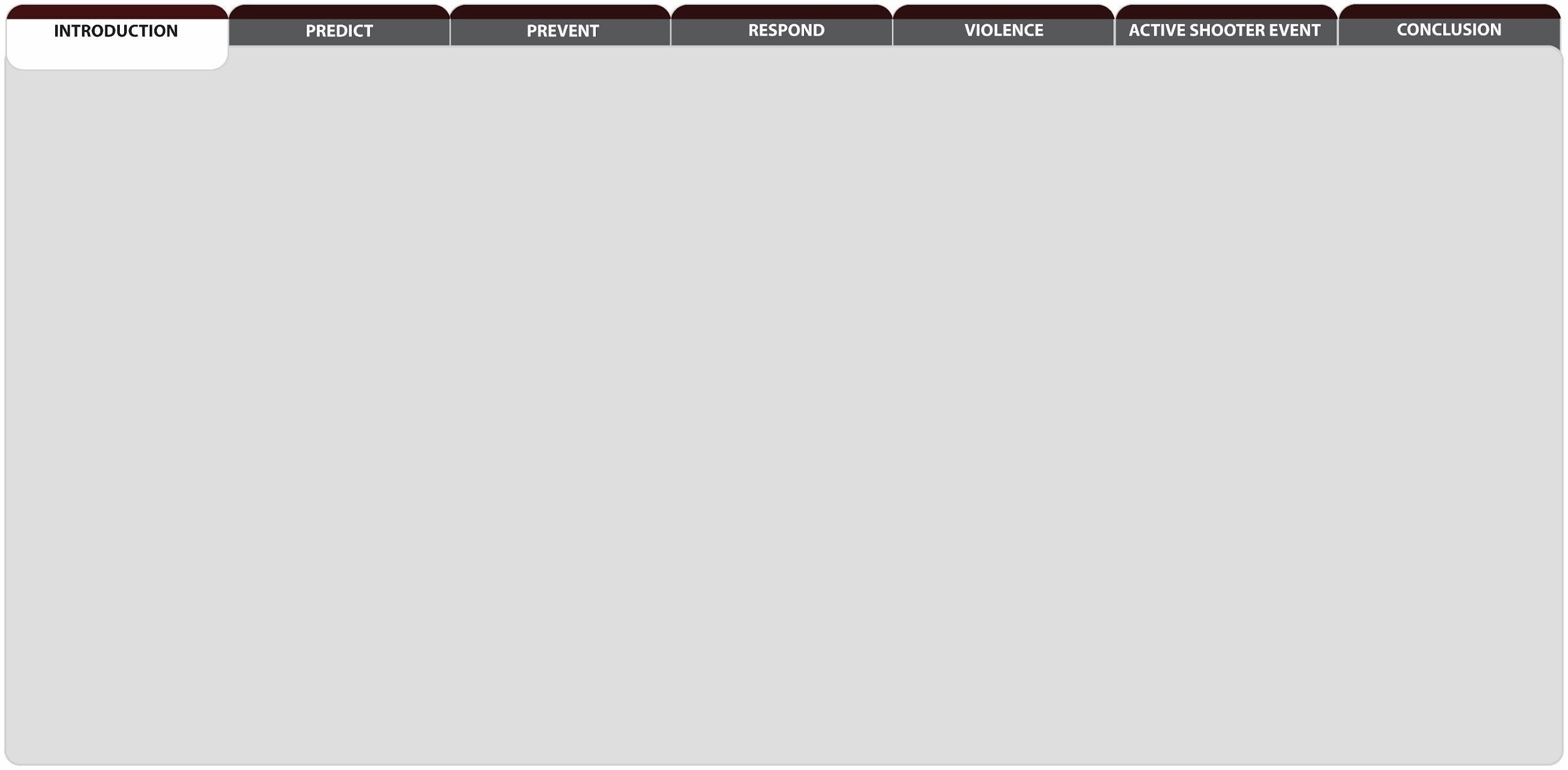

Welcome to Safety Training!
Welcome to SOFG Safety and Awareness Training. Today, we will talk about violence in the workplace. This is never a pleasant topic to deal with, but workplace violence needs to be dealt with decisively. Workplace violence will not stop on its own – it’s up to all of us to fight against it. Today’s training strives to provide you with the tools and information that help you maintain a safe and productive workplace for yourself and those with whom you work.

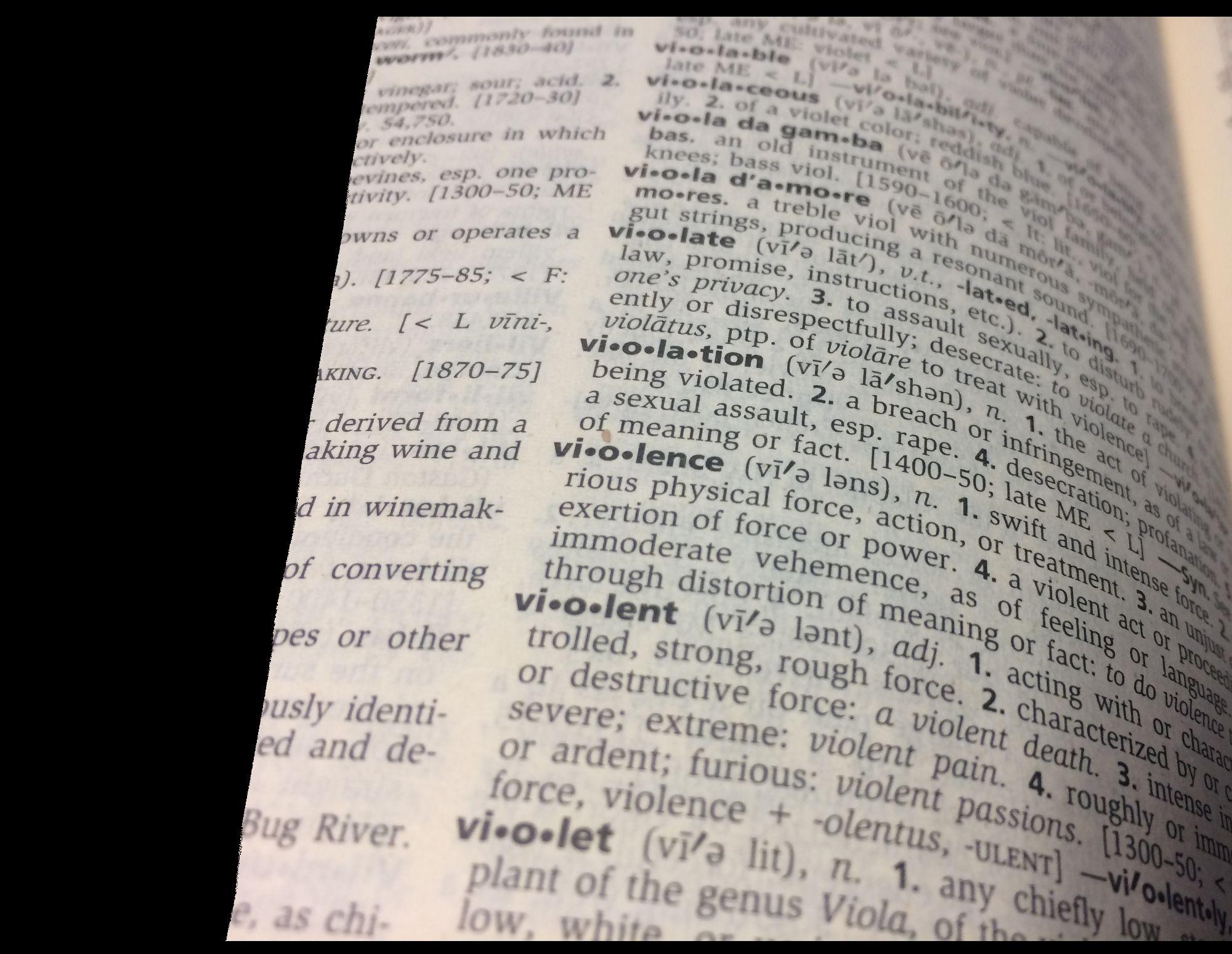
Copyright Safety Provisions, Inc. VIOLENCE ACTIVE SHOOTER CONCLUSION


Did you know?
Two million associates are victims of workplace violence each year.


What is Workplace Violence?
Any behavior that causes anxiety, fear, and a climate of distrust in your workplace is part of workplace violence. However, we cannot cover all rude or disrespectful behavior that may occur where you work. Rather, our goal is to empower you to recognize and take action against alarming conduct before it leads to violence.


Copyright Safety Provisions, Inc. PREDICT PREVENT RESPOND VIOLENCE ACTIVE SHOOTER CONCLUSION

If left unchecked, harassment, bullying, and other threatening behaviors may result in serious, violent actions, including stalking and assault. In fact, one behavior leads to another, until what started as unprofessional behavior and intolerance ends in violence. Preventing workplace violence requires us to pay attention to more than actual physical attacks. Any conduct that creates a climate of fear, anxiety, or distrust is part of workplace violence, and should be addressed before physical violence erupts.




Copyright Safety Provisions, Inc. PREDICT PREVENT RESPOND VIOLENCE ACTIVE SHOOTER CONCLUSION

Today, we will discuss the different types of violence, recognizing and reporting alarming behaviors, and how to de-escalate a tense situation. We will also go over prevention measures and how to respond to a violent situation. Ending workplace violence is not an easy goal, but taking this training is a significant step in recognizing and preventing violence in your workplace.




Copyright Safety Provisions, Inc. PREDICT PREVENT RESPOND VIOLENCE ACTIVE SHOOTER CONCLUSION

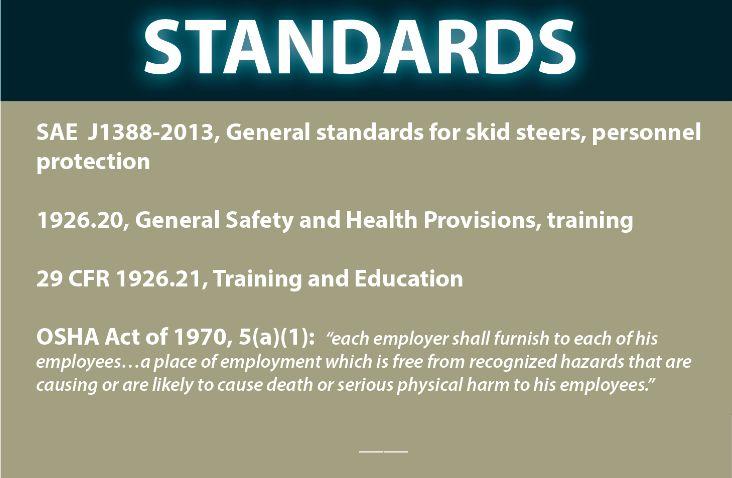
Section 5(a)(1) General Duty Clause: Each employer furnish to each of its employees a workplace that is free from recognized hazards that are causing or likely to cause death or serious physical harm.

California’s Division of Occupational Safety and Health Administration (Cal/OSHA) enforces Senate bill 553, which requires most employers to develop, implement, and maintain a Workplace Violence Prevention Plan (WVPP) by July 1, 2024.


Copyright Safety Provisions, Inc. PREDICT PREVENT RESPOND VIOLENCE ACTIVE SHOOTER CONCLUSION
SOFG, Inc. has a legal and ethical obligation to develop and maintain a workplace that is free from threats and violence in all its forms. You and your associates have the right to work in an atmosphere that promotes the safety and well-being of all.











Copyright Safety Provisions, Inc. PREDICT PREVENT RESPOND VIOLENCE ACTIVE SHOOTER CONCLUSION

Some states or local jurisdictions have specific laws regarding violence in the workplace. This training is not intended to be a comprehensive look at all applicable laws. Rather, it is a general safety training to give you the tools to recognize and prevent violence in your workplace. Contact your local authorities to find out more about the specific laws as they pertain to your workplace.



Copyright Safety Provisions, Inc. PREDICT PREVENT RESPOND VIOLENCE ACTIVE SHOOTER CONCLUSION

Impact
Obviously, violence in the workplace affects society as a whole. Like all violent crime, workplace violence creates ripples that reach beyond a single victim. It damages trust and the sense of security you should feel whenever you’re on the job. In that sense, violence in the workplace takes a toll on everyone, and we all have a stake in preventing it.



Copyright Safety Provisions, Inc. PREDICT PREVENT RESPOND VIOLENCE ACTIVE SHOOTER CONCLUSION

That being said, the true cost of workplace violence for SOFG Inc. is the negative impact it has on the organization as a whole. Nonfatal injuries sustained in acts of workplace violence usually result in missed work. In fact, more than half of the associates who miss work due to workplace violence miss at least three days. Some associates may simply quit after such an incident. If a serious event occurs, it is not unusual for a business to close down for several days. While these costs are difficult to calculate, some estimates place them in billions, or even tens of billions, of dollars annually.



Copyright Safety Provisions, Inc. PREDICT PREVENT RESPOND VIOLENCE ACTIVE SHOOTER CONCLUSION



For the victims of violence, the cost is much more personal. You don’t need to be the direct target of workplace violence in order to be victimized by it. Witnessing these events can take a toll, as well. Associates who view the violent act reported on the news can feel victimized, even if they weren’t at work at the time of the incident.


Copyright Safety Provisions, Inc. PREDICT PREVENT RESPOND VIOLENCE ACTIVE SHOOTER CONCLUSION

Psychological
Aside from any physical injuries they may have sustained, victims of workplace violence can experience serious, disabling psychological damage. Victims have an increased risk of PTSD. Psychological and emotional effects of violence could also include fear or anxiety, depression, irritability, and disturbed relationships with family, friends, and coworkers.




Copyright Safety Provisions, Inc. PREDICT PREVENT RESPOND VIOLENCE ACTIVE SHOOTER CONCLUSION



The psychological trauma of workplace violence, while common, is rarely given enough attention, even though evidence shows victims and witnesses of violent incidents require long-term treatment to fully recover from these issues.


Copyright Safety Provisions, Inc. PREDICT PREVENT RESPOND VIOLENCE ACTIVE SHOOTER CONCLUSION
Physical
The stress and anxiety associated with violence in the workplace can lead to sleep issues, high blood pressure, loss of appetite, headaches, and weight fluctuations. These physical effects of violence can manifest in the workplace, leading to a serious loss of productivity.





Copyright Safety Provisions, Inc. PREDICT PREVENT RESPOND VIOLENCE ACTIVE SHOOTER CONCLUSION
Financial
Taking into account the physical and psychological effects of workplace violence, it shouldn’t be surprising that victims often take sick days or unpaid leave in order to recover. It is difficult to truly quantify the financial burden of violence on victims, since it is estimated that only one in four instances of workplace violence are actually reported.




Copyright Safety Provisions, Inc. PREDICT PREVENT RESPOND VIOLENCE ACTIVE SHOOTER CONCLUSION
Definitions
As we discussed earlier, violence in the workplace can describe a wide range of behaviors. Let’s take a moment to become more familiar with some of the terms we’ll be using in this training.






Copyright Safety Provisions, Inc. PREDICT PREVENT RESPOND VIOLENCE ACTIVE SHOOTER CONCLUSION
Workplace Violence

Most people think of physical assault when they hear the term workplace violence. However, anytime someone is abused, threatened, intimidated, or assaulted in their place of employment, it is workplace violence. Workplace violence is any act or threat of physical violence. It can range from verbal abuse to physical assaults, and even homicide. Because this is a vast range of behaviors, we will be focusing on physical violence and active shooters in this training.




Copyright Safety Provisions, Inc. PREDICT PREVENT RESPOND VIOLENCE ACTIVE SHOOTER CONCLUSION



Workplace violence is not limited to incidents that occur within your workplace or the work site. Work-related violence can occur at off-site business-related functions, such as conferences or trade shows; at social events related to work, such as a holiday party; or away from the workplace but resulting from work (a threatening telephone call to your home from a guest, for example).


Copyright Safety Provisions, Inc. PREDICT PREVENT RESPOND VIOLENCE ACTIVE SHOOTER CONCLUSION




Violence can be split into two different categories in the workplace: Inherent Violence and Situational Violence. As the name implies, Inherent Violence occurs in occupations where the risk of encountering violence is built-in (such as law enforcement or healthcare professionals). For our purposes today, we will not be discussing Inherent Violence in depth. Jobs that have an inherent violence risk already have highly-specialized trainings and regulations in place that cannot be fully explored in this format.


Copyright Safety Provisions, Inc. PREDICT PREVENT RESPOND VIOLENCE ACTIVE SHOOTER CONCLUSION
Situational Violence is directly related to your coworkers and your workplace, rather than a specific occupation or job. Situational violence can be instigated by coworkers, guests, or previously employed associates. Everyone is subject to unpredictable behaviors and outside forces that influence them at work. This is the type of violence we will be focusing on today.





Copyright Safety Provisions, Inc. PREDICT PREVENT RESPOND VIOLENCE ACTIVE SHOOTER CONCLUSION
Active Shooter

Although relatively rare, active violence events in the workplace cannot be ignored. You only have to turn on the news to be reminded that no one is immune to these events. For the purpose of this training, we will refer to them as active shooter events. An active shooter event refers to anyone engaged in killing or attempting to kill people in the workplace.
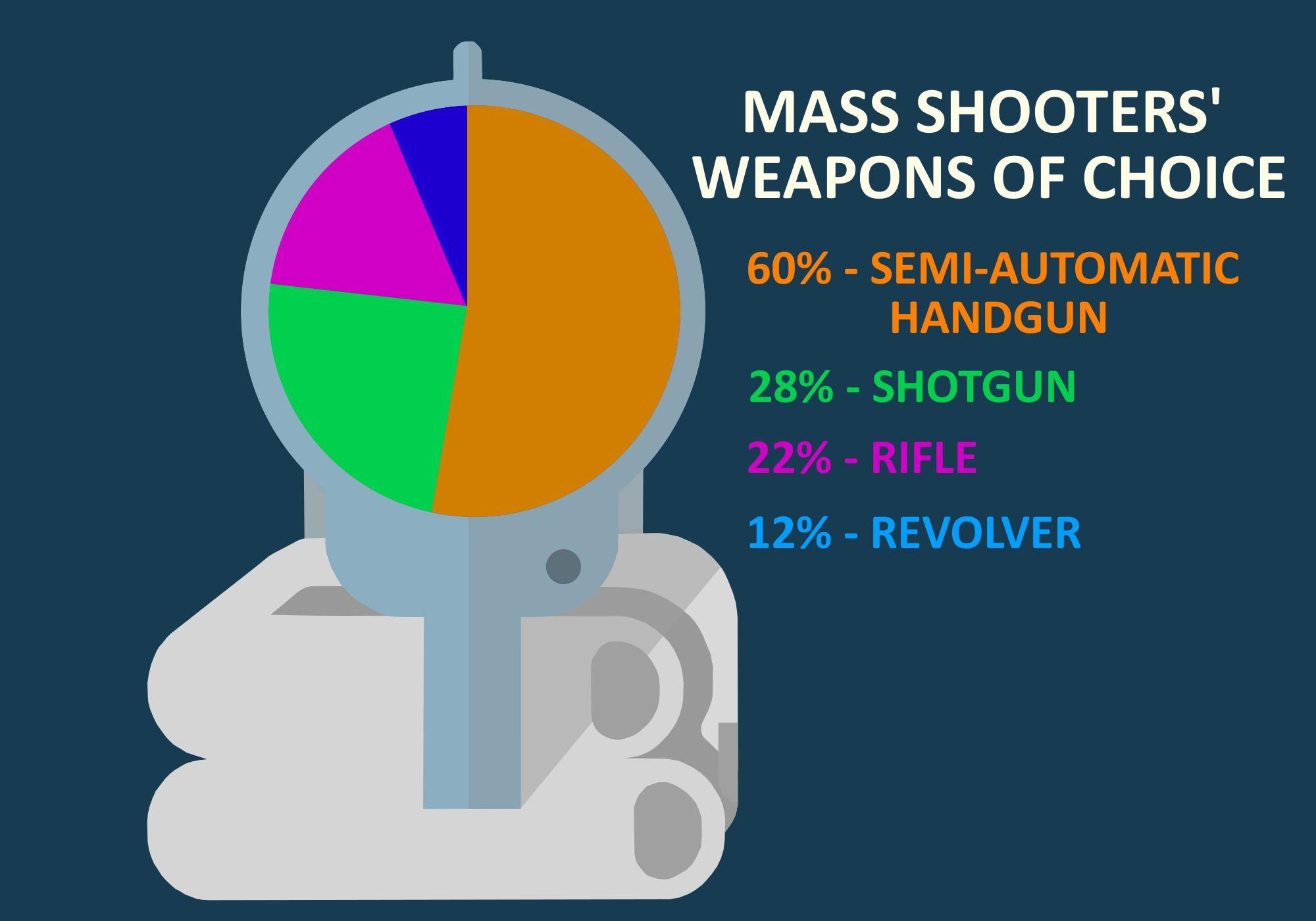


Copyright Safety Provisions, Inc. PREDICT PREVENT RESPOND VIOLENCE ACTIVE SHOOTER CONCLUSION
Perpetrators of an active violence event can use a number of weapons. Keep that in mind throughout today’s training, even though we will be referring to these events as “active shooter” events, since firearms are used in most cases.

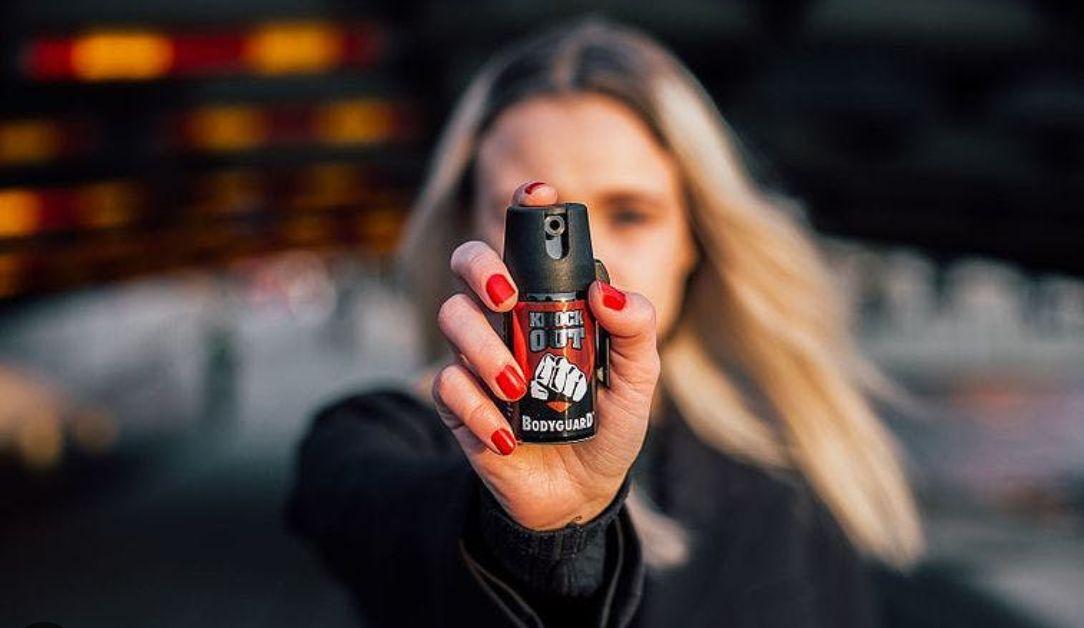



Copyright Safety Provisions, Inc. PREDICT PREVENT RESPOND VIOLENCE ACTIVE SHOOTER CONCLUSION
Ignorance Is Not An Excuse
“I didn’t know,” is not an excuse for instigating or tolerating any type of violence in your workplace. You have been provided with this training so you can keep yourself safe, but also so you can recognize questionable behaviors around you and safeguard others.





Copyright Safety Provisions, Inc. PREDICT PREVENT RESPOND VIOLENCE ACTIVE SHOOTER CONCLUSION
Preparedness and awareness are the keys to protecting yourself, your coworkers, and your guests. Beware of apathy. Don’t fall into the trap of thinking it has never happened at your workplace and never will. Be proactive and take measures to prepare for an act of violence in your workplace.

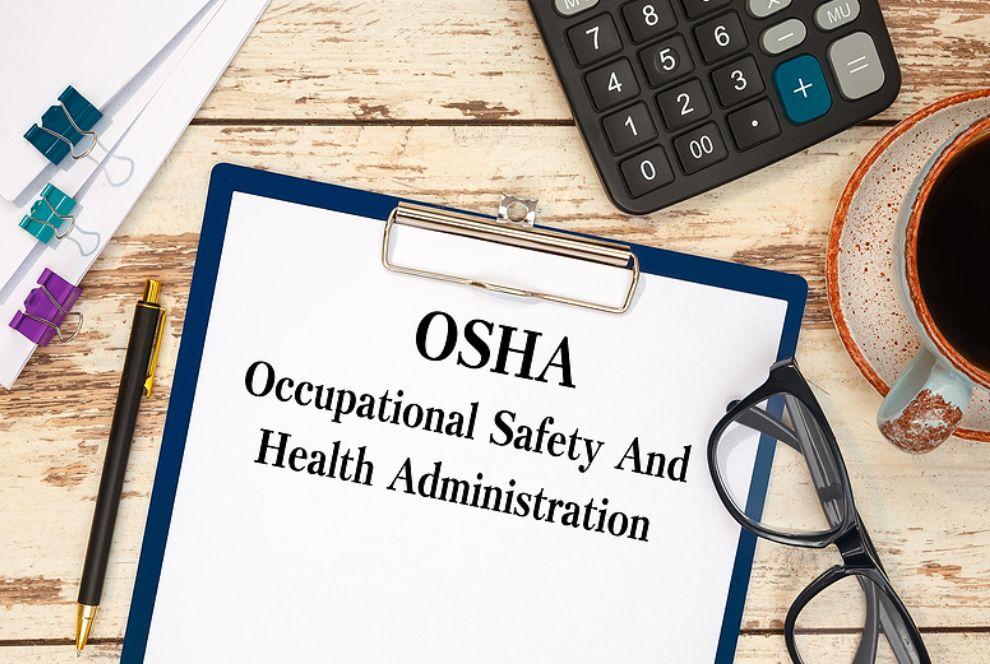




Copyright Safety Provisions, Inc. PREDICT PREVENT RESPOND VIOLENCE ACTIVE SHOOTER CONCLUSION
Predict





The idea that someone “just snapped” without warning is a myth. Workplace violence is not random or unpredictable. In most cases, there are warning signs that lead up to an act of violence, which means you can predict and prevent violence in your workplace. In this section, we will discuss these warning signs, how to recognize them, and what to do if you see them. We’ll also talk about how to predict violence using situational awareness.





Copyright Safety Provisions, Inc.
Situational Awareness




Copyright Safety Provisions, Inc.
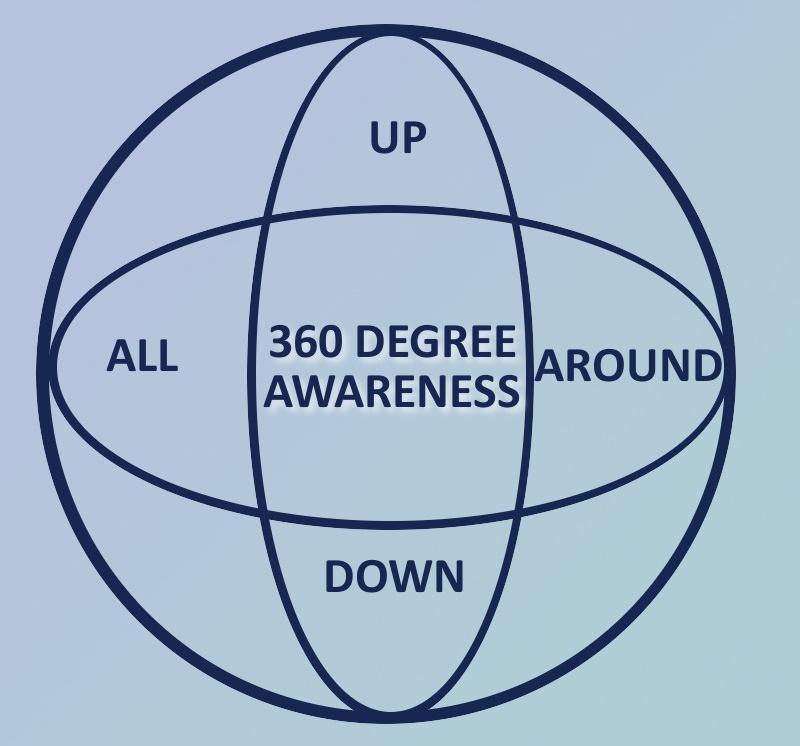
Situational awareness is being conscious of your surroundings in a way that helps you quickly determine the context and relevance of unfolding events. When you are situationally aware, you know who or what could be helpful if a problem arises. Situational awareness is sometimes referred to as a “360 Degree Mindset.” That is, you are aware of not only what is in front of you or to either side, but also what is behind, above, and below you. A phrase used by law enforcement and military personnel describes it perfectly: Up, down, and all around. You never want to say, after a violent event, “I never saw it coming.”




Copyright Safety Provisions, Inc.
Cooper Color Code
Colonel Jeff Cooper believed that the most important weapon in a lethal confrontation was not a gun or a knowledge of martial arts. Rather, he taught that the mind is anyone’s best weapon in violent situations. To help people prepare their minds for danger, he developed and taught the Cooper Color Code.

Did you know?
Col. Cooper developed the two-handed Weaver stance, illustrated here. Before this stance, most handguns were fired with only one hand.





Copyright Safety Provisions, Inc.




The Cooper Color Code, sometimes referred to as just Cooper’s Colors, has been used in the military and law enforcement world for decades. We present it here to give you an idea of your own awareness levels from day to day.


Copyright Safety Provisions, Inc.

Condition White is a state of being completely unaware of your surroundings or what is going on. You could be distracted by your phone, or just daydreaming. In Condition White, you are oblivious to hazards or threats and your environment as a whole.





Copyright Safety Provisions, Inc.



It’s easy to slip into Condition White at work. You have your routine, and every day seems blend into the next. By nature, humans are creatures of habit, and too often, each of us becomes complacent about our safety.



Copyright Safety Provisions, Inc.

Condition Yellow is described as a state of relaxed alertness. If you are in Condition Yellow, you are paying attention to the people, sights, and sounds around you. You recognize that danger is always a possibility, so you are noticing other people’s body language and tones of voice. You know where the exits are. You may even note objects that could be used as weapons in an emergency.




Copyright Safety Provisions, Inc.
Being in Condition Yellow doesn’t mean you are paranoid or anxious. It allows you to stay aware of your surrounding and protect yourself and others from threats. It helps you spring into action when needed. Ideally, you should strive to be in Condition Yellow as often as possible. You can achieve this by asking yourself, “Who is where? What are they doing? What will they do next?”





Copyright Safety Provisions, Inc.

If you’ve moved into Condition Orange, that means you feel someone or something could pose a threat to your safety. You’ve identified a “red flag.” It could be a backpack that has been sitting unattended or a stranger loitering in the parking lot. In Condition Orange, you are thinking of ways to deal with the apparent danger.
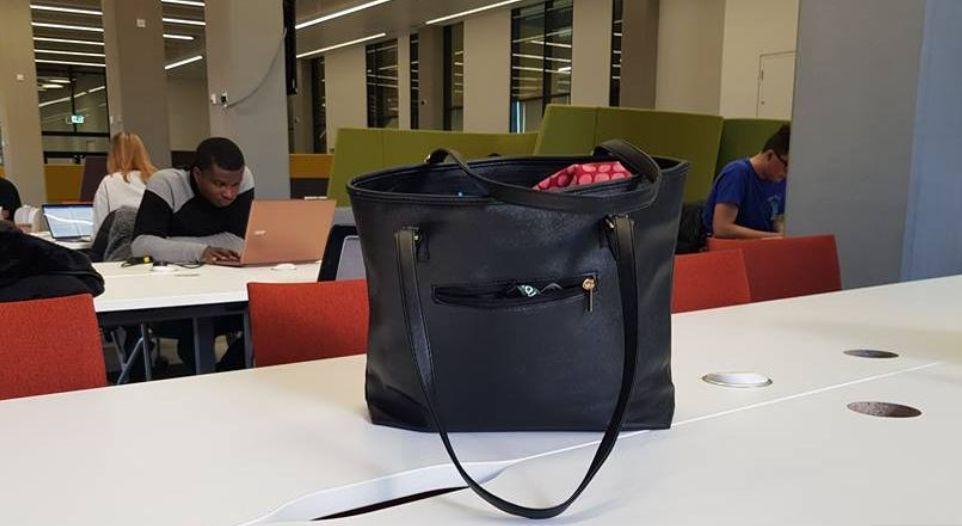




Copyright Safety Provisions, Inc.
Red is the color of action. Something has happened that has you in “fight or flight” mode. Condition Red is exhausting, both mentally and physically; your body is releasing adrenaline to deal with danger, and you’re entire awareness if focused on the threat at hand. You will notice little, if any, of what is happening around you.





Copyright Safety Provisions, Inc.
In Condition Black, you are not aware of your actions or the situation. The time for decision-making is gone. You are acting on instinct, and all cognitive processing has ceased. Condition Black can occur when you are actively engaged in a violent situation.






Copyright Safety Provisions, Inc.

Remember, being situationally aware doesn’t come naturally; it is a skill you will have to practice, but it is essential you master it. It will help reduce the likelihood you will become a victim, and give you an advantage when you are put at risk.




Copyright Safety Provisions, Inc.
Bystander Intervention Training is likely to include at least four strategies:
Recognizing Alarming Behaviors
Create awareness—Enable bystanders to recognize potentially problematic behaviors.
Create a sense of responsibility—Motivate bystanders to step in and take action when they see problematic behaviors.
Create a sense of empowerment—Conduct skills-building exercises to help workers gain the skills and confidence to step in.
Provide resources—Give workers the resources they can utilize in their intervention.




Copyright Safety Provisions, Inc.

Risk factors for violence can stem from personality conflicts (at home or at work), financial or legal problems, or emotional and psychological disturbances. How can you identify violent people? How do you know when to move from Condition Yellow to Condition Orange? While no one outside of a mental health profession can accurately predict violent behavior, there are indicators everyone can watch for.




Copyright Safety Provisions, Inc.
“Strange” Behaviors

Stay alert to odd behavior in your workplace. If your outgoing coworker suddenly becomes quiet and withdrawn, that could be a sign of bigger issues at play. Conversely, if your normally quiet coworker shows increased belligerence, or adopts behaviors that are harassing or aggressive, it can also be a precursor to violent behavior.




Copyright Safety Provisions, Inc.
Threats
Everyone says things they don’t really mean in the heat of the moment. Sometimes it’s a threat. You do not have to tolerate threats in the workplace, whether they are uttered by a coworker, leader, or a guest. Threats are legally considered part of workplace violence, not just a precursor.

Did you know?
Pornography is the representation in books, magazines, photographs, films, and other media of scenes of sexual behavior that are erotic or lewd and are designed to arouse sexual excitement in its audience. Two million workers are assaulted each year, but those assaults are preceded by six million instances of associates being verbally threatened.





Copyright Safety Provisions, Inc.

A lot of weight is put on not only what is said, but how it is said. “I’m going to beat your brains in,” becomes more than an idle threat when the person saying it has something in their hand or is shaking a fist. Even threatening horseplay can be a warning sign of escalating behaviors. When in doubt, it is better to take a threat seriously. Erring on the side of caution could be the difference between safety and disaster.




Copyright Safety Provisions, Inc.

Bringing Weapons To Work
Most businesses have a strict policy about bringing weapons of any sort into the workplace or work site. Because concealed-carry laws vary widely from one jurisdiction to the next, it can be difficult to know if a weapon is legal or not. A safe practice is to report any weapon to a supervisor or leader, especially if the person in question doesn’t have a history of carrying a concealed weapon. Buying a new weapon or suddenly becoming fascinated with guns and other weapons can be a warning sign, as well.





Copyright Safety Provisions, Inc.



There are no federal laws governing weapons in a private workplace. However, some states or provinces and local jurisdictions do have restrictions on them. Make yourself aware of all laws relevant to your situation, as well as any policies specific to your workplace. Adhere to these laws and policies with exactness.
In accordance with the SOFG Inc. Code of Conduct you should not be in possession of: alcohol, illegal drugs, explosives or hazardous materials, weapons or offensive materials while on SOFG Inc. property.




Copyright Safety Provisions, Inc.

Threats Of Suicide
A suicide threat might not seem like a threat to your own safety, but it is a serious sign of violent intent. Some extreme acts of violence are, in fact, suicide. In these cases, the perpetrator wounds or kills others with the expectation of being killed by law enforcement. Additionally, many workplace shootings end in the perpetrator killing themselves. Never ignore suicide threats.

Did you know?
Committing an act of violence in hopes of being killed by law enforcement officers is commonly referred to as “suicide by cop.” It is estimated that 10% of people killed by law enforcement officers each year are cases of suicide by cop.




Copyright Safety Provisions, Inc.
Interpersonal Conflicts

Conflict at work is inevitable. Coworkers are bound to disagree from time to time. However, if someone you work with is having an increased number of conflicts with coworkers or supervisors, that could be a red flag. When confronted about their behavior, an escalating person may become defensive or hostile; they might blame others for the issues they’re having and won’t take responsibility for their part in the conflict.




Copyright Safety Provisions, Inc.
Drug Or Alcohol Abuse

Drug or alcohol use is not unusual, especially outside of work. However, when that use crosses over into abuse—that is, when it begins affecting someone’s work life, or when they begin using drugs and alcohol at work, it is time to be concerned. It isn’t just alcoholics who can present an issue at work. The majority of alcohol-related workplace issues come from non-dependent drinkers who may occasionally drink too much.




Copyright Safety Provisions, Inc.

Performance Issues
Another red flag is an increase in performance issues. Has your coworker received unfavorable performance reviews lately? Have they been reprimanded by leadership for unacceptable work? Again, they may blame their issues on someone else—a leader or coworker, rather than taking responsibility for the underlying issue.





Copyright Safety Provisions, Inc.
Emotional Distress
When you are experiencing stress in your personal life, it affects your work life. Serious family or financial problems can cause additional stress on anyone. Divorce, a death in the family, or even underlying psychological issues like anxiety or depression can take their toll at work, leading to poor performance, one of our other warning signs.






Copyright Safety Provisions, Inc.



Personal issues can affect your work, health and family. The Associate Assistance Program provides support, resources and information for personal and work-life issues such as: marriage and family problems, job-related issues, stress, anxiety and depression, parent and child relationships, legal and financial counseling and more.
This program is confidential and provided at no cost.


Copyright Safety Provisions, Inc.
Call 1-800-854-1446 24/7 to learn more.

It bears repeating that no test or list of behaviors is positive proof that an associate, guest, or coworker will become violent. Rather, employers and employees should be alert to alarming behaviors that, mixed with other risk factors, could point to possible violence. No single behavior we have discussed, in and of itself, suggests a great potential for violence. Consider them all as a whole. Watch for many signs together, rather than just one or two.






Copyright Safety Provisions, Inc.
Prevent
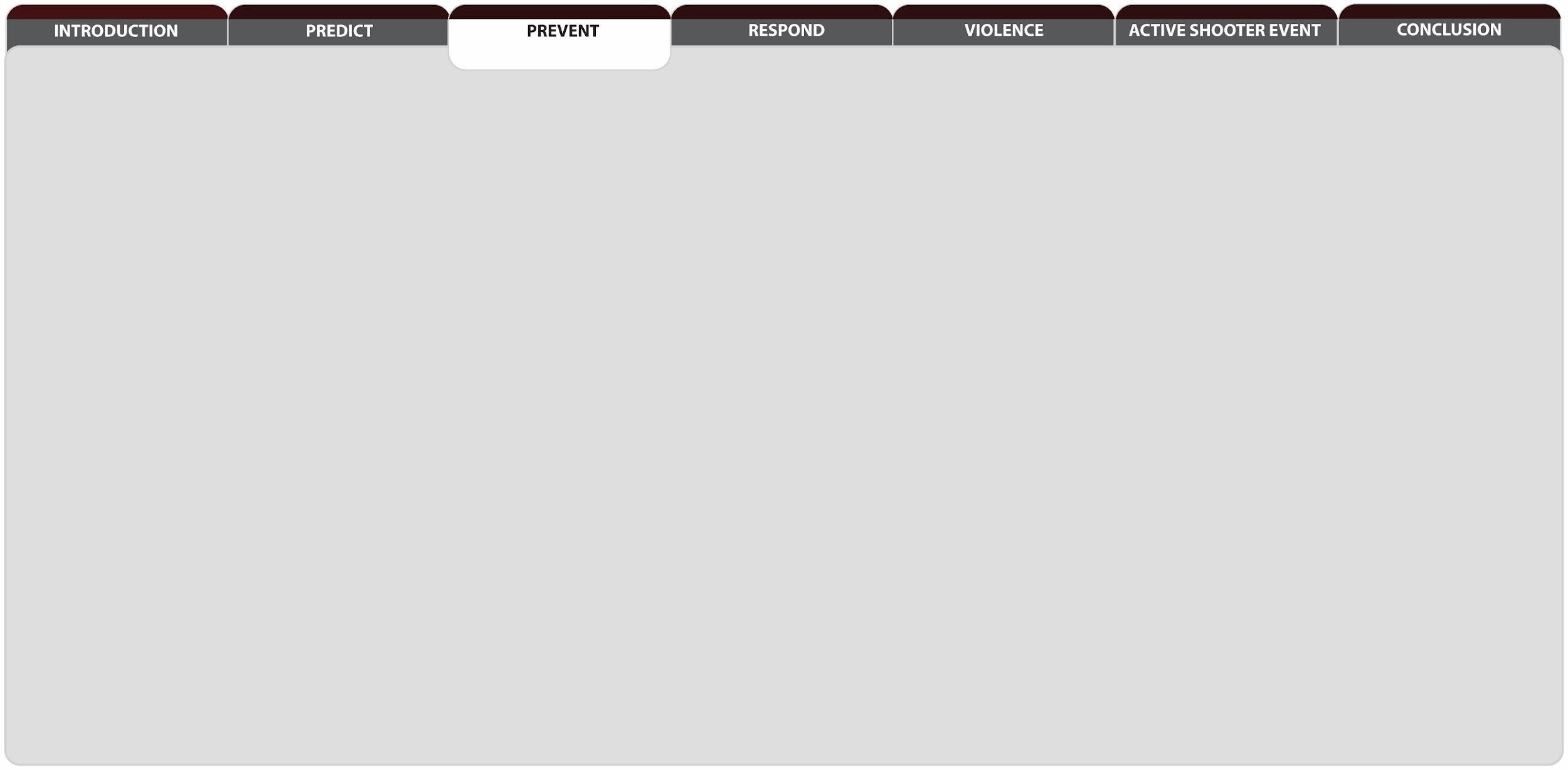




Now that you understand how to predict violent behavior, we can move into how to prevent it. By taking measures to prevent violent behaviors, you are ensuring the safety of everyone in your workplace. We’ll go over how to recognize and de-escalate dangerous situations, and steps you and the company can take to ensure a safe working environment.




Copyright Safety Provisions, Inc.
De-Escalating




Copyright Safety Provisions, Inc.

We have learned how to predict violent behavior, now let’s take a look at how to recognize alarming behaviors in others. Take a few minutes to to think about how you can recognize when you are getting out of control, not only when confronted with violence, but anytime you are faced with stress in the workplace. The saying goes, “The only person you can control is yourself,” and that holds true in the workplace, as well.




Copyright Safety Provisions, Inc.
You will regularly come in contact with people who don’t share your core ethics of dignity, fairness, and respect. Everyone has had a run-in with a difficult guest or a leader who berated them during a meeting. You feel your breath quicken, and your blood pressure rises. You feel like punching your computer, throwing your phone, or just screaming at the top of your lungs. This is






Copyright Safety Provisions, Inc.
The stress everyone feels at their jobs can be harmful, both physically and emotionally. Don’t confuse stress with feeling challenged. Challenges are energizing; they motivate you to learn new skills and master your job. However, if you are feeling stressed, there are a few things you can do to help release your frustration and refocus on your job. Remember, you are a professional; your employer and your coworkers are relying on you to keep the workplace safe.

Did you know?
A number of factors play a part in reducing stressful working conditions:
• Balance between work and family or personal life
• A support network of friends and coworkers
• A relaxed and positive outlook





Copyright Safety Provisions, Inc.
Breathe

You’ve heard it before, from the time you were a child. Count to 10. Take a few deeps breaths, take a step back, and give yourself even just 10 seconds to process. Put things in perspective. That can be hard to do when you feel attacked, but it could help defuse a potentially volatile situation.




Copyright Safety Provisions, Inc.

Tactical Breathing
Whenever you feel overwhelmed or you are struggling to control yourself, be mindful of your breathing. This can help mitigate the effects of stress and allow you to regain control of yourself. The goal is to decrease your blood pressure, slow your breathing and heart rate, and relax your muscles. The tactical breathing method has been used by first responders, military, and athletes to help them focus, gain control, and manage stress. Try it next time you feel like you are overwhelmed or losing control.




Copyright Safety Provisions, Inc.

Write It Down
Sometimes, putting your feelings into words is just what you need. When verbalizing your emotions isn’t the wisest choice, grab a pen and paper and vent on the page. After you feel better, shred (or permanently delete, if using a computer) the document and move on.





Copyright Safety Provisions, Inc.
Vent

If you have a trusted friend or colleague with whom you can discuss work-related issues, do so. It can be helpful to talk about your stress or aggravation to someone who understands the company’s culture and work environment. It can give you perspective.




Copyright Safety Provisions, Inc.
Seek Outside Support
A quick text or call to a friend or family member can be just what you need to reestablish your internal balance. They can be your cheerleader and offer moral support in times of stress.






Copyright Safety Provisions, Inc.
Get Out
If you’re really having a rough day—someone took credit for your work, or a big project fell through—one of the best things you can do is remove yourself from the situation. Take your lunch break, or just walk around outside for a few minutes. Getting away and changing your environment will provide you with the physical and mental distance needed to relax.







Copyright Safety Provisions, Inc.
De-escalating Others
As we’ve discussed, people get angry or stressed for all sorts of reasons. You should know how to deal with angry people in your workplace, whether they are guests or coworkers. It may be up to you to calm them down so they don’t harm you or others.






Copyright Safety Provisions, Inc.
Communicate Respect
Show the person you are interested in solving the issue or meeting their needs and concerns. Listen to them. Acknowledge the importance of their concern. Use non-aggressive body language and don’t openly judge their behavior.





Copyright Safety Provisions, Inc.
Cooperate

Demonstrate that you understand why they are angry. Don’t point out reasons they shouldn’t be upset, but you don’t necessarily have to agree with their reasonings, either. Focus on communicating empathy for their feelings. You aren’t trying to make the anger go away completely, just keep them from escalating to violence.




Copyright Safety Provisions, Inc.
Listen

Anytime you are trying to defuse anger, focus on understanding the person. Listening skills are essential in helping you learn the base root of the issue. Everyone wants to feel heard and understood. You do not have to agree with the angry person but do show them you have listened to their complaints and understand where they are coming from. Phrases such as, “If that happened to me, I would probably feel angry, too,” can go a long way toward making the disgruntled person feel understood.




Copyright Safety Provisions, Inc.

To avoid misunderstandings or misinterpretation of the situation, paraphrase, clarify, and gather information. However, don’t interrupt the angry person, even if you know of a solution before they stop speaking. Remember, you are there to listen with the intent to understand. You should avoid arguing with them, as well. In fact, rational arguments may only provoke them further, as you will come across as defensive or confrontational. Don’t talk too much, and use their name if you know it.




Copyright Safety Provisions, Inc.
Body Language
Be mindful of your nonverbal communication. Shaking your head, fidgeting or frowning can undermine the message you’re trying to get across. Don’t stand directly facing the angry person; rather, stand at an angle or sideways. This can help keep the situation non-adversarial.






Copyright Safety Provisions, Inc.



Use open body language, as illustrated here. Make sure your arms and legs are not crossed. You can use your arms to animate what you are saying. Keep your hands open, so the angry person can see you aren’t holding anything, and to further indicate your openness to what they are saying.

Did you know?
Forcing someone to use their hands breaks the crossed-arms position of closed body language. Giving the person something to hold or look at could help them de-escalate.


Copyright Safety Provisions, Inc.


Likewise, if the person confronting you begins using open body language, that can mean they are de-escalating and becoming more passive. Watch for open hands, with the palms held upward, or hands relaxed at their sides. If their fists are clenched, be on your guard. Beware if the angry person keeps their upper body tense, even if they are not crossing their arms; this is a sign of aggression—they are holding their body in readiness to fight, rather than de-escalating.




Copyright Safety Provisions, Inc.
Reframing

When you’re faced with a hostile coworker or guest, it is natural to push back. Reframing helps you change direction. Take a mental step back and ask yourself if you are seeing the issue clearly, or if you can look at it differently. Ask yourself, “How do I want to react in this situation?” and “How would I want to be treated if the roles were reversed?”
Reframing reflects understanding and changes the emphasis from differences to common ground.





Copyright Safety Provisions, Inc.
Assert Yourself
Sometimes, you will need to assert yourself in order to manage the situation. Set firm, clear boundaries for appropriate behavior. Phrases such as, “I want to help you, but I can’t do that if you are yelling,” are a great way to set boundaries. However, remember that assertive requests aren’t always appropriate. Cooperation is always essential.





Copyright Safety Provisions, Inc.
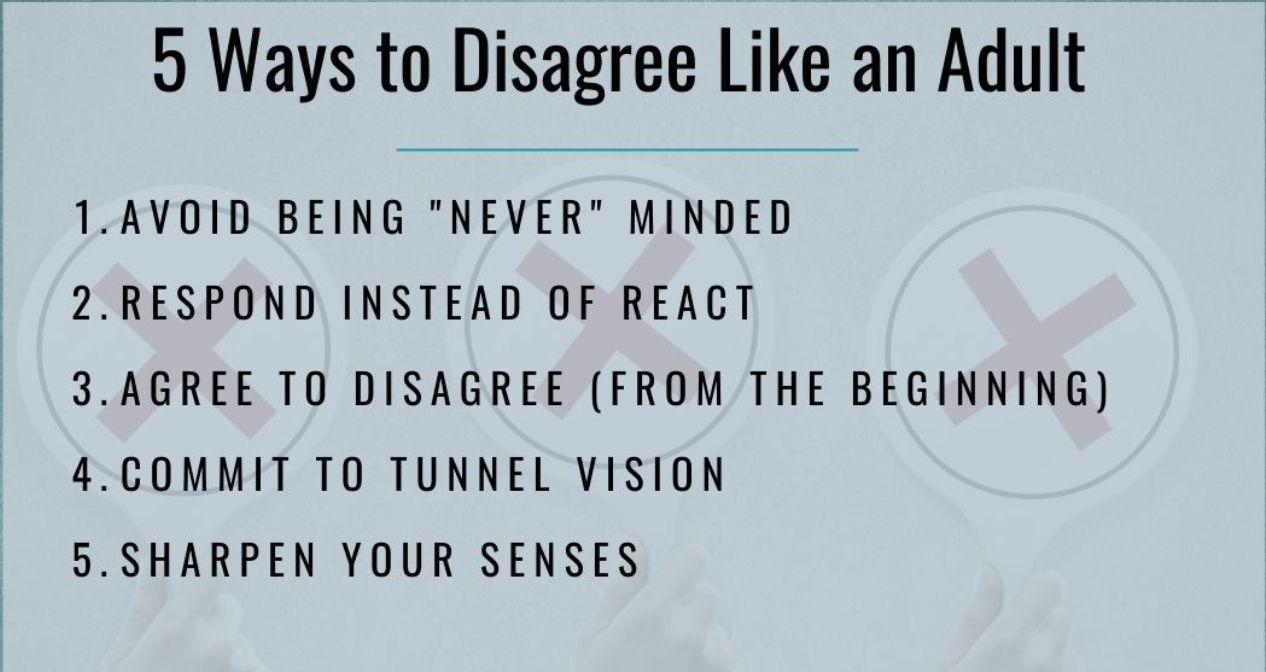
Always use “I” statements when speaking during a disagreement. Using “you” statements can make the angry person feel as if you are accusing them or blaming them. “I feel anxious when you yell, and I am having a hard time listening to you,” is a good example of an “I” statement. Also avoid using “we” statements. Referring to yourself in the first person humanizes you.




Copyright Safety Provisions, Inc.
Disengage

If you find yourself getting too upset to continue speaking with someone, or if you fear for your safety, leave the area, if possible. Explain your need for a break, and have a supervisor or coworker take over.




Copyright Safety Provisions, Inc.
Despite your best efforts, the situation may spiral out of control. If the disgruntled guest or furious coworker begins to show signs of losing control, take steps to protect yourself and your coworkers. If you notice any of these signs, use caution:
• Turning red in the face
• Breathing becoming erratic
• Flexing their fists
• Clenching their jaw






Copyright Safety Provisions, Inc.
Controls




Copyright Safety Provisions, Inc.

Engineering Controls
Engineering controls are methods that reduce exposure by redesigning the procedure or task. The basic idea is to isolate workers from any hazard. For our purposes today, engineering controls are measures taken to reduce your exposure to violence in your workplace. Engineering controls for reducing your exposure to potential violence could include improved lighting, access keys and codes, and the use of better or additional lighting.






Copyright Safety Provisions, Inc.

Keypads
Keypads don’t require keys in the traditional sense. Rather, the lock is released by a numeric code. Each associate has their own code that they enter for access to the building or office space. This reduces the risk of unauthorized entry by the public, vendors, or former employees.





Copyright Safety Provisions, Inc.
Key Cards
Key cards are perhaps the most-used security option. They are operated by swiping an authorized card, which then unlocks the door. This allows building managers or business owners to control who goes where by validating the key card for different locks. They can also be used to keep record of who is accessing different areas in the building.





Copyright Safety Provisions, Inc.

Lighting
Proper security lighting can reduce the risk of assault, as well as reduce theft and vandalism. High-risk areas, such as parking garages and parking lots, should be well-lit. Outdoor lighting is essential to helping ensure your safety. Look at these examples. Which area would you feel safer walking in?





Copyright Safety Provisions, Inc.

Cameras
A video surveillance system can help deter intruders and provide evidence, should an act of violence occur in your workplace. Since modern workplaces have more and more visitors, cameras can help monitor who is allowed in the building. Security cameras can be used inside and outside a building; signs should be posted indicating their use.





Copyright Safety Provisions, Inc.

Panic Buttons
Panic alarms, when available, should be installed where employees encounter the public, such as the lobby. Panic alarms can be silent or audible. Associates can even have personal panic buttons in the form of a watch or keychain. Associates should be trained on how and when to deploy the panic alarms and where they are located.

Did you know?
When used properly, panic buttons can provide respondents with the information your company has entered into the alert system, reducing response time.





Copyright Safety Provisions, Inc.

Administrative Controls
Administrative controls are policies and practices designed to reduce hazards in the workplace; in this case, the risk of violent events. Administrative controls, in this situation, can include employing security guards or receptionists who screen calls and visitors, among several other options.






Copyright Safety Provisions, Inc.
Training
Training is the most important administrative control your company can have in place to prevent violence from occurring. You and your coworkers should know how to identify alarming behaviors and which steps you can take to prevent or stop the behavior from turning into violence.






Copyright Safety Provisions, Inc.

You should have safety training on a regular basis so you know what conduct is unacceptable and what do to if you are a victim or a witness to violence in the workplace. An effective training should:
• Occur once a year
• Teach employees to recognize the sound of gunshots
• Teach employees to react quickly when gunshots are heard or shooting is witnessed
• How to call 911 and what information to give
• How to react when Law Enforcement Officers arrive
• Teach employees to adopt the survival mindset during times of crisis




Copyright Safety Provisions, Inc.


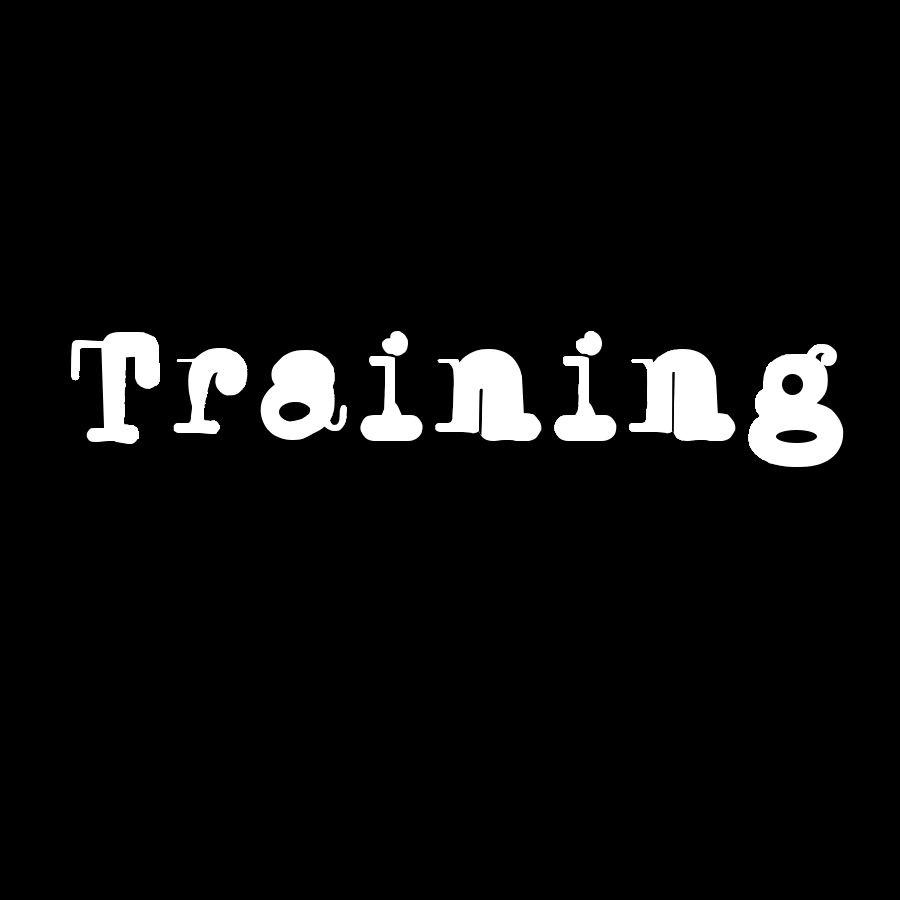

Last, but not least, trainings should include a chance to practice what you’ve learned. Run emergency drills at least once a year. No matter how thorough or well-conceived, preparation won’t do any good if no one remembers how to respond when an emergency does occur. Training drills should include anyone who would be making decisions during a real incident. Utilize local law enforcement whenever possible. For best results, exercises or drills should be followed by careful evaluation and changes to fix whatever weaknesses have been revealed.
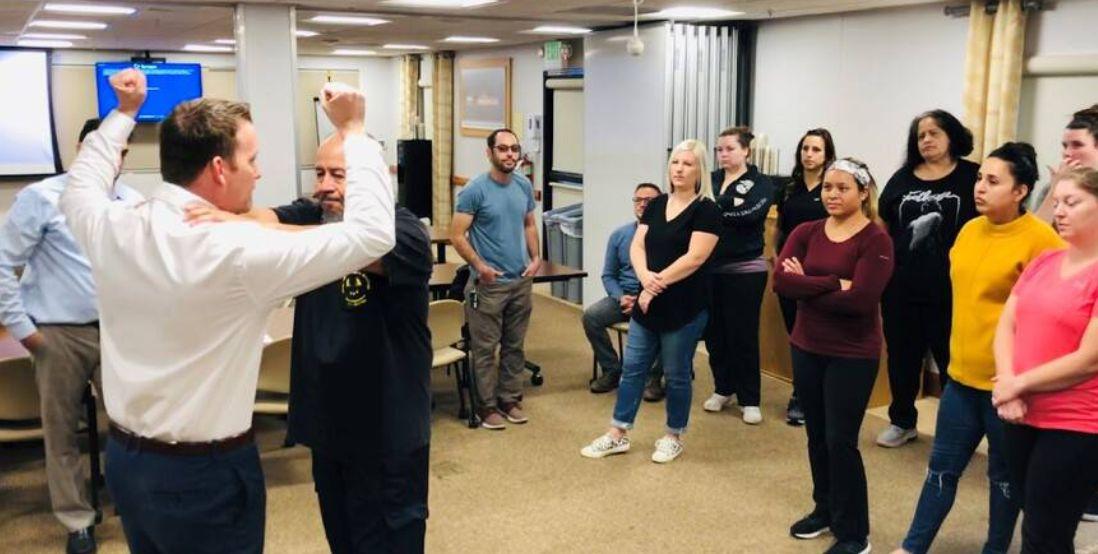




Copyright Safety Provisions, Inc.
Bystander Intervention
Bystander Intervention Training is relatively new to the workplace, though it has been used on college campuses and in high schools to prevent sexual assault. These trainings empower students or employees to intervene with peers to prevent assaults from occurring.


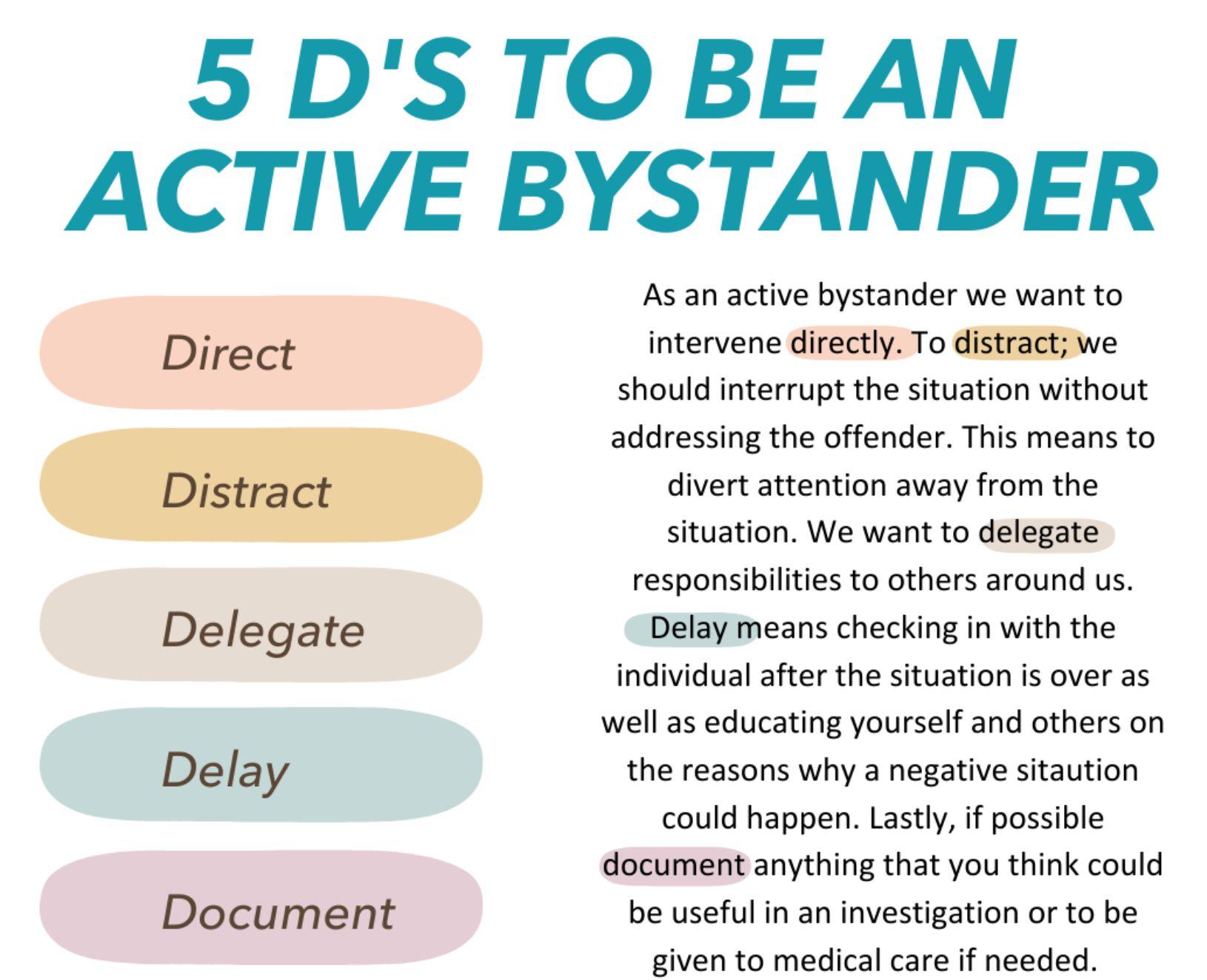


Copyright Safety Provisions, Inc.

Culture
Culture is one of the most effective administrative controls pertaining to workplace violence. The culture of your workplace is set by the values of the organization. These values should put a premium on diversity and inclusion. A healthy work culture illustrates that all employees deserve to be respected.




Copyright Safety Provisions, Inc.




A clear, consistent message should be projected to all employees through workplace practices and policies: violence will not be tolerated in any form. When leadership values a workplace free of harassment and violence, it will establish a sense of urgency about preventing these behaviors. Leaders should take a visible role in stating and modeling the importance of having a safe workplace where all employees feel valued.

Copyright Safety Provisions, Inc.



Showing dedication to an inclusive culture means making employees accountable for their actions. If employees know their concerns and complaints are taken seriously, investigated quickly and thoroughly, and discipline measured out when needed, they are more likely to report issues. This leads to a reduction in violence occurring in the workplace.




Copyright Safety Provisions, Inc.
Sign-In Procedures

Sign-in procedures can be used to monitor who is in the building in case of a catastrophic event, including violence. A sign-in log is a simple tool that emergency responders can use to immediately account for who is in your workplace.




Copyright Safety Provisions, Inc.



You will find most workplaces use a sign-in book, though some businesses have been moving toward electronic systems. Visitor badges are usually given to non-employees and vendors who sign in so they are easily distinguished from the regular employees.



Copyright Safety Provisions, Inc.
Respond




If you find yourself the victim of violence, or if you’ve noticed some alarming behaviors, the biggest question on your mind is, “What do I do about it?” In this section, we’ll talk about the steps you can take to stop violence before it starts.





Copyright Safety Provisions, Inc.
Zero Tolerance
The best protection employers can offer is to establish a zero-tolerance policy toward workplace violence. All employees should know the policy and understand the procedures for reporting violence. Any claims should be investigated and remedied right away.





Copyright Safety Provisions, Inc.
Reporting
Safety in the workplace should be everyone’s goal and responsibility. All employees, including leaders, should feel free to report behaviors that seem disturbing or out of character. If you do not feel comfortable going to your leader you may call the anonymous hotline at 1-888-662-5025 or email peopledevelopment@altardstate.com


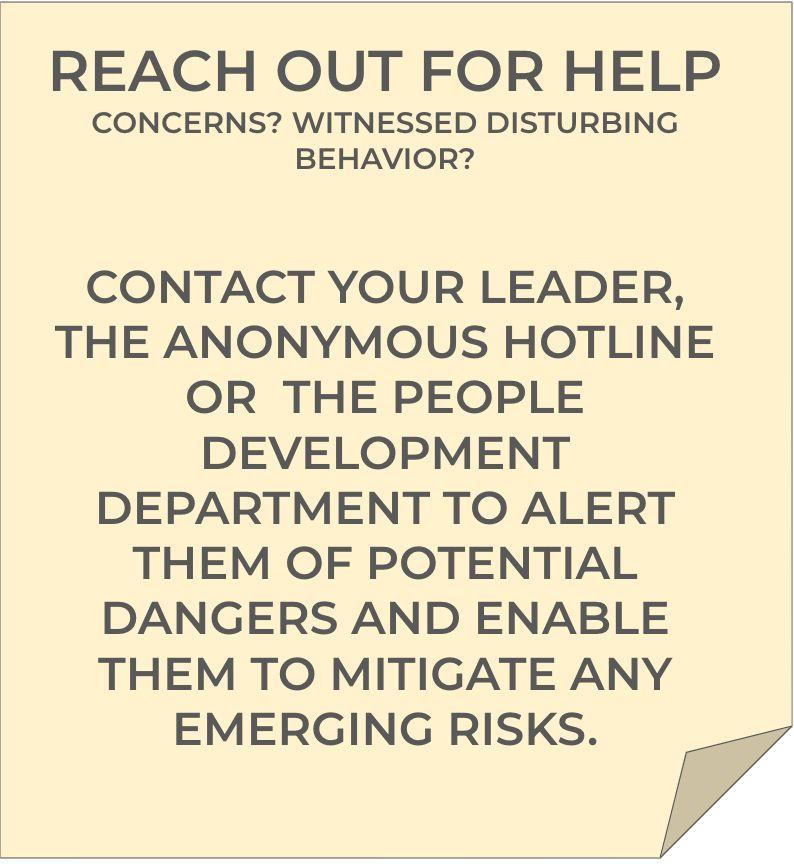


Copyright Safety Provisions, Inc.


Early, accurate reporting can be the key to resolving issues before they escalate into physical violence. Procedures for reporting incidents will vary according to the type of behavior that has occurred, and the intensity of it. Depending on the situation, resources available within the company, and the need for involving law enforcement, the reporting process could go to one or more of the following people or entities:
• The associate’s leader
• Your company’s security department (if there is one)
• People Development Team
• Local law enforcement


Copyright Safety Provisions, Inc.

If you are uncertain of your company’s reporting policies, make a point of finding out. Remember, these are your friends and coworkers needing help resolving issues, not just behaviors to worry about. Reporting is the first step in that process. You don’t need to feel disloyal or think of yourself as a “tattle-tail.” You are acting as part of a solution before the problem becomes overwhelming. Again, associates should feel encouraged to document and report concerning behaviors. A clear, simple means of reporting should be in place, with the option to stay anonymous, if you wish, to minimize fears of retaliation.





Copyright Safety Provisions, Inc.
Three C’s Of Hesitation
There are three main reasons that people don’t report alarming behaviors. These are referred to as the Three C’s of Hesitation. They are confidentiality, comradery, and concern. The next few slides will go over each of these reasons for hesitation.
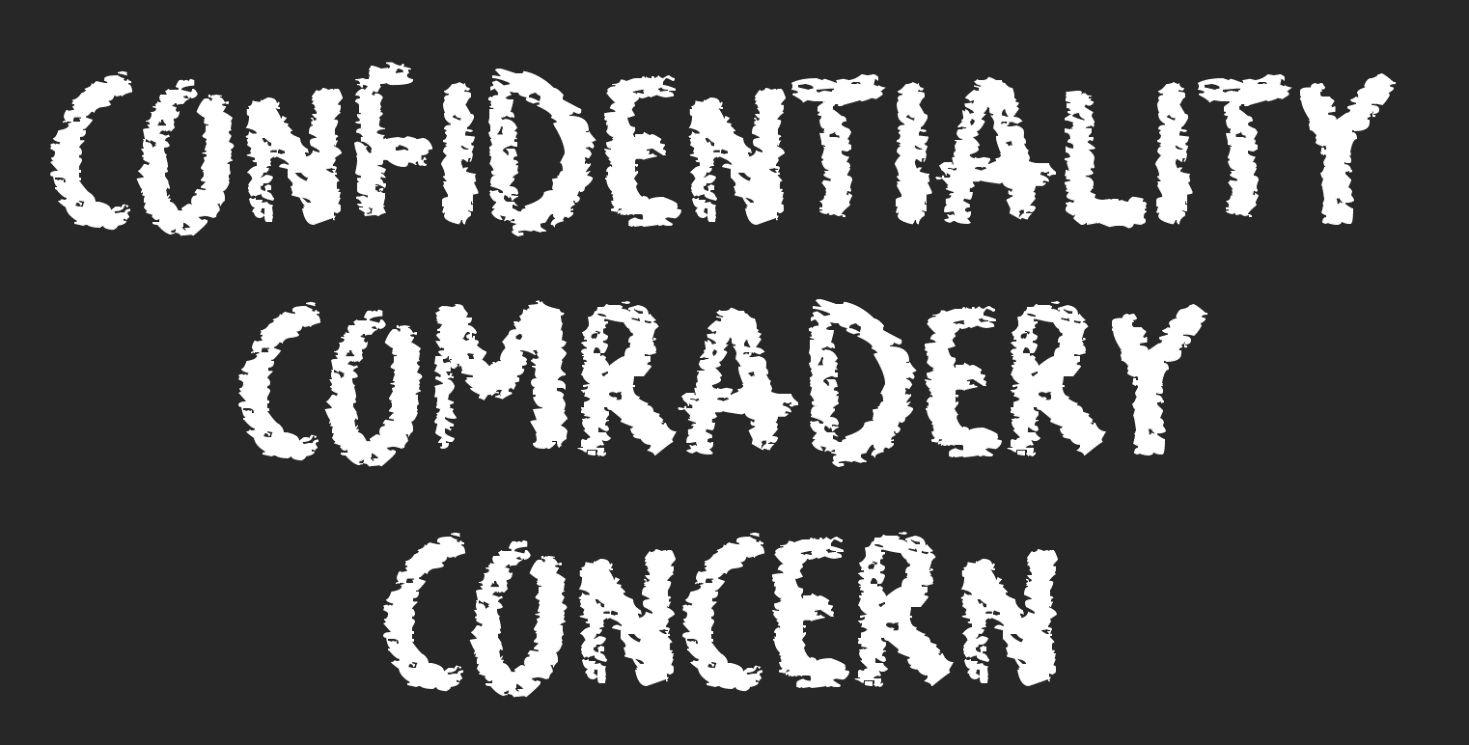





Copyright Safety Provisions, Inc.

Confidentiality
The employee feels that if they report alarming behavior, they would be breaking a friend’s trust. Perhaps the red flags came up in a conversation meant as a vent to dispel stress, or you noticed some alarming behavior while you were socializing away from the workplace. Reporting your friend and coworker feels like an act of betrayal to a friendship you may value greatly.




Copyright Safety Provisions, Inc.
Comradery
No one wants to be viewed as a troublemaker in the workplace. Reporting alarming behaviors can feel like you’re “ratting out” a coworker or team member to leadership. Keep in mind you are not reporting the behaviors to get your coworker into trouble; you are trying to help them resolve issues they may be having.





Copyright Safety Provisions, Inc.
Concern
The last reason for hesitating to report behaviors is concern. Many associates worry about reporting any adverse behaviors (including sexual harassment and bullying in the workplace) for fear of retaliation. If the coworker in is a leader or in a place of authority, you may fear losing your job or being demoted.



Administrative Investigations
After a report is made, an employer must investigate the claims. Investigations should be conducted in a fair and objective manner. The goal of an investigation should be gaining truthful responses to issues that may come to light, so maintaining an atmosphere of candor and propriety is key.






Copyright Safety Provisions, Inc.

Investigations should always be conducted with possible legal outcomes in mind. Actions taken during the investigation should not hinder potential criminal prosecutions. If you are part of an investigation, answer questions honestly and frankly. Your individual privacy and possibly even your identity should always be protected by investigators.




Copyright Safety Provisions, Inc.

Emergency Action Plan
Every workplace should have an emergency action plan or crisis response plan. These plans describe procedures to follow during a fire or other emergency, including an act of violence. Emergency action plans should include actions for those with disabilities (such as specific escape routes), and a section for guests and visitors. The emergency action plan should be offered in multiple languages.





Copyright Safety Provisions, Inc.
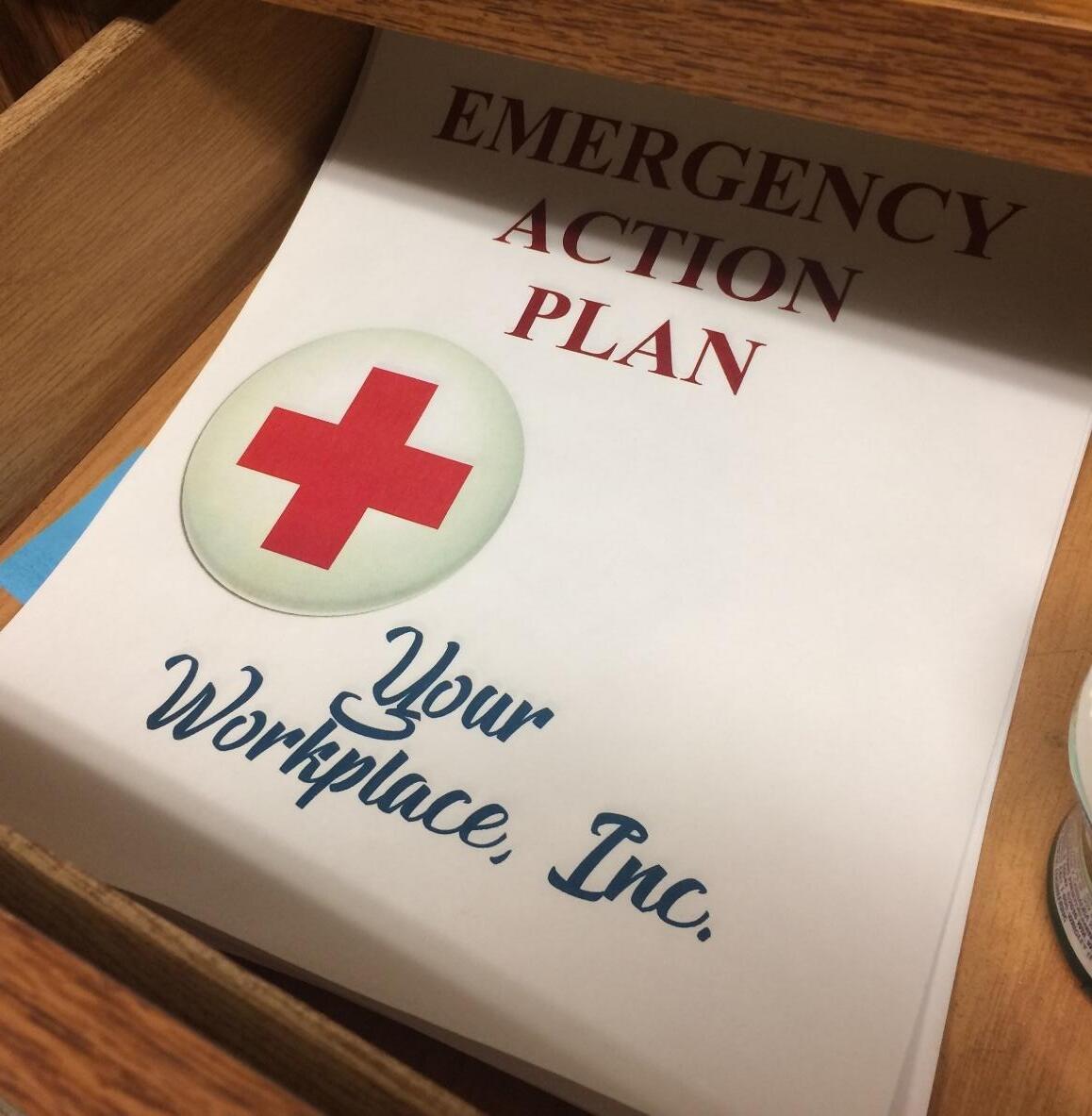
Every employee should have their own copy of an emergency plan, outlining procedures to follow in case of fires, bomb threats, threats of violence (both inside and outside the office), and natural disasters. An emergency plan should also include these components:
• Preferred method for reporting emergencies
• Evacuation policy and procedure
• Emergency escape procedures
• Escape route assignments
• Information for (and responsibilities of) individuals to be contacted in case of emergency
• Information on local hospitals (name, contact info, distance)
• Emergency notification system
• Clear instructions on what actions to take
• How to assist First Responders
• Run, Hide, Fight




Copyright Safety Provisions, Inc.
Violence



It is important to note that all of the following behaviors are illegal. They are considered physical assault and are punishable by law. You should report these behaviors to local authorities immediately so they can take appropriate action. Most of these incidents aren’t reported to company officials, let alone to police. Do not suffer in silence. Speak up!






Copyright Safety Provisions, Inc.
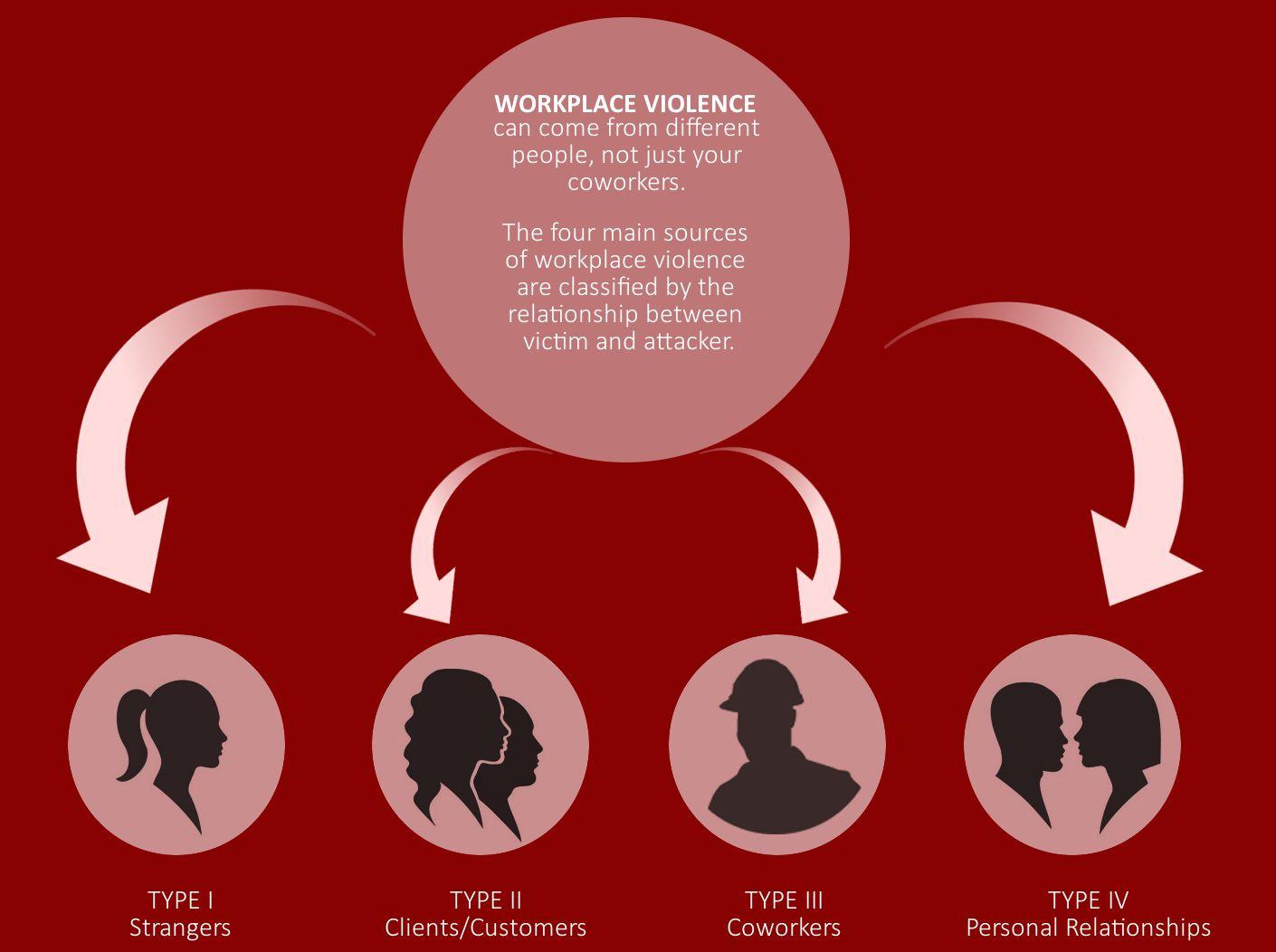
Violence can be instigated by a number of different people, not just your coworkers.
Violence in the workplace can be identified in four broad categories, which are listed to the left. Take a moment to look them over before we explore them in more detail.




Copyright Safety Provisions, Inc.
Type 1
Type 1 violence is committed by criminals who have no other connection with your workplace. The motive is usually theft, and the criminal will likely be carrying a weapon of some sort.
Type 1 violence usually occurs in a particular occupational group; mainly, jobs where workers are vulnerable, like taxi drivers, late-night retail, or gas station clerks. These jobs require workers to be on duty at night, in isolated areas, or by themselves. They also have access to cash. An example of Type 1 violence would be a robbery at a convenience store.

Did you know?
The most common motive for jobrelated homicide is robbery. It is estimated that 85% of workplace homicides are committed during an act of robbery.





Copyright Safety Provisions, Inc.
Type 2
Type 2 violence is instigated by guests or anyone for whom your company provides services. Usually, the violence occurs while you are performing your normal tasks and going about your daily routine.





Copyright Safety Provisions, Inc.
Much of Type 2 violence is inherent, and is aimed at those dealing with dangerous people as part of their job. Examples include policemen, correctional officers, or healthcare workers.

Did you know?
Workers experiencing the largest number of Type 2 assaults are those in healthcare occupations, nurses in particular. In fact, the healthcare sector experiences almost as many injuries due to violence as all other industries combined.







Copyright Safety Provisions, Inc.

For victims not working in inherently dangerous industries, the violent reactions of a guest are unpredictable. Violent behavior can be triggered by an argument, anger due to quality of service (or refusal of service), delays, or some other reason altogether.




Copyright Safety Provisions, Inc.
Type 3
Type 3 violence is instigated by an associate or former associate. It is directed against coworkers or leaders. All workplaces have a risk of Type 3 violence occurring. No one is immune. Type 3 violence can include stalking, threats (written and verbal), and physical assault.






Copyright Safety Provisions, Inc.
Type 4

Type 4 violence is perpetrated by someone who isn’t an employee, but has a personal relationship with someone in your workplace. This could be an abusive spouse or domestic partner. Type 4 violence is often domestic violence spilling over into the workplace.




Copyright Safety Provisions, Inc.

The violent acts that fall into Types 1 and 2 are just as dangerous as behaviors seen in Types 3 and 4. They are damaging on many levels, just like any other violent act. However, because Types 3 and 4 are instigated by people you know—either in your personal life or work life—you have a better chance at recognizing warning signs and reporting any alarming behavior. This is why we will be focusing on Types 3 and 4 today. Now, let’s take a few minutes to explore what kind of violent behaviors are experienced most in the workplace. The safety principles we’ll be discussing can be applied to Types 1 and 2, as well.





Copyright Safety Provisions, Inc.
Hitting, Kicking & Shoving
Strike, slap, punch: these are all words used to describe the same act of violence. Punching involves a closed fist, while slapping is done with an open hand. Hitting can include using an object to strike someone. Today’s workplace often brings together people who have different personalities, cultures, and power dynamics. It can make for a tense environment that can lead to violence.

Battery is any unwelcome touching
The damages resulting from battery (including medical expenses for injuries suffered, lost wages due to missed work, property damage, etc.) form the basis of any financial award.


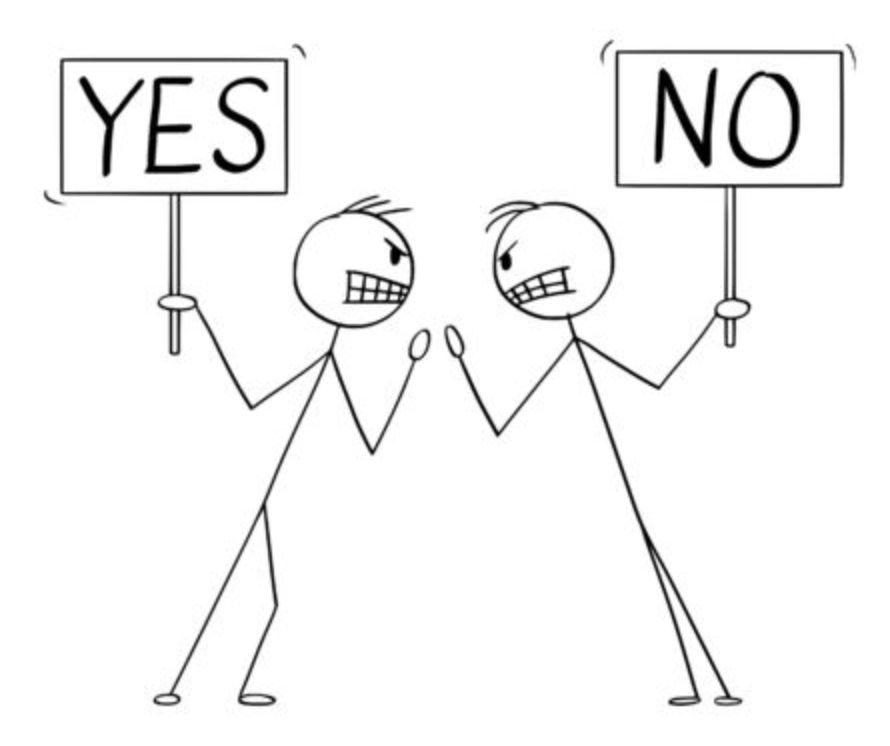


Copyright Safety Provisions, Inc.
Beating

Beating implies one or more of the previously-discussed actions being done repeatedly or by more than one person. Beatings can occur between individuals or they can involve a group. The physical damage from a beating is significant, and the injuries sustained could be serious, even life-threatening. Anyone who assaults another person in the workplace can be charged and sued for damages. Unfortunately, such attacks can and do happen every day, in every industry.




Copyright Safety Provisions, Inc.
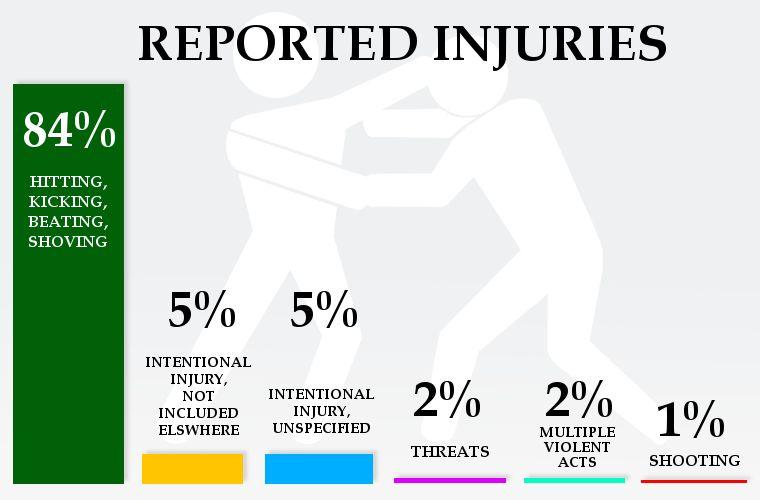
In fact, the vast majority of violent acts reported every year include hitting, kicking, beating, and shoving. That’s almost 1400 incidents a year. And when you consider that only a small number of assaults are actually reported, the numbers become even more alarming.




Copyright Safety Provisions, Inc.

Stalking
Stalking is unwanted and unwarranted continued attention and contact from the perpetrator toward the victim. It occurs when the perpetrator is obsessed or fixated with the victim. Stalking makes the victim feel afraid, nervous, or harassed.





Copyright Safety Provisions, Inc.

Stalking behaviors can include, but are not limited to the following:
•Telephone calls (silent, pleading, angry, or threatening conversations)
•Following or giving the impression the victim has been followed
•Retrieving personal information or details (physically or online)
•Threats
•False complaints to employers
•False legal claims
•Criminal damage (home/work/vehicle)
•Sending unsolicited gifts




Copyright Safety Provisions, Inc.
Stalking is usually associated with Type 4 violence, as it is often an integral part of domestic violence. Workplace stalking can arise from many different contexts besides domestic violence, as well. These could include guests stalking staff, guests stalking other guests, and associates stalking co-workers.






Copyright Safety Provisions, Inc.

Understandably, employers can be hesitant about addressing personal relationships. While privacy is a legitimate concern, when violence in the form of stalking comes through the workplace door, it becomes the employer’s concern, as well. Remember, employers have the moral and legal obligation to provide a workplace where you and your coworkers are all safe and free from hazards—including those posed by other people.




Copyright Safety Provisions, Inc.




The most effective way to reduce the impact of stalking in your workplace is to determine how the victim and other employees can be supported. A real danger for stalking victims is that coworkers are often unaware of the stalking danger, particularly receptionists and those responsible for entry into a business. Employers should make these kinds of employees aware of stalking situations.

Did you know?
An Anti-Stalking law was passed in the U.S. in 1996. The Violence Against Women Act (VAWA) made it a federal felony to cross state lines to stalk or harass an individual if the conduct causes fear of serious bodily injury or death to the victim or to the victim's immediate family members.

Copyright Safety Provisions, Inc.
Homicide
Nearly 80% of workplace homicides are due to Type 1 violence. The remaining homicides represent a small percentage of workplace violence. Again, homicide is on a continuum of behaviors that begins with harassment and bullying. Trying to prevent workplace homicides while ignoring other forms of workplace violence is ineffective. Keep that in mind as we begin talking about Active Shooters.

Did you know?
Despite a number of highly publicized post office incidents, a Postal Service commission reported that postal employees are actually less likely to be victims of workplace homicide than other workers. “Going postal” is a myth, even though the phrase is still used everyday to refer to violence acts.





Copyright Safety Provisions, Inc.
Active Shooter Event
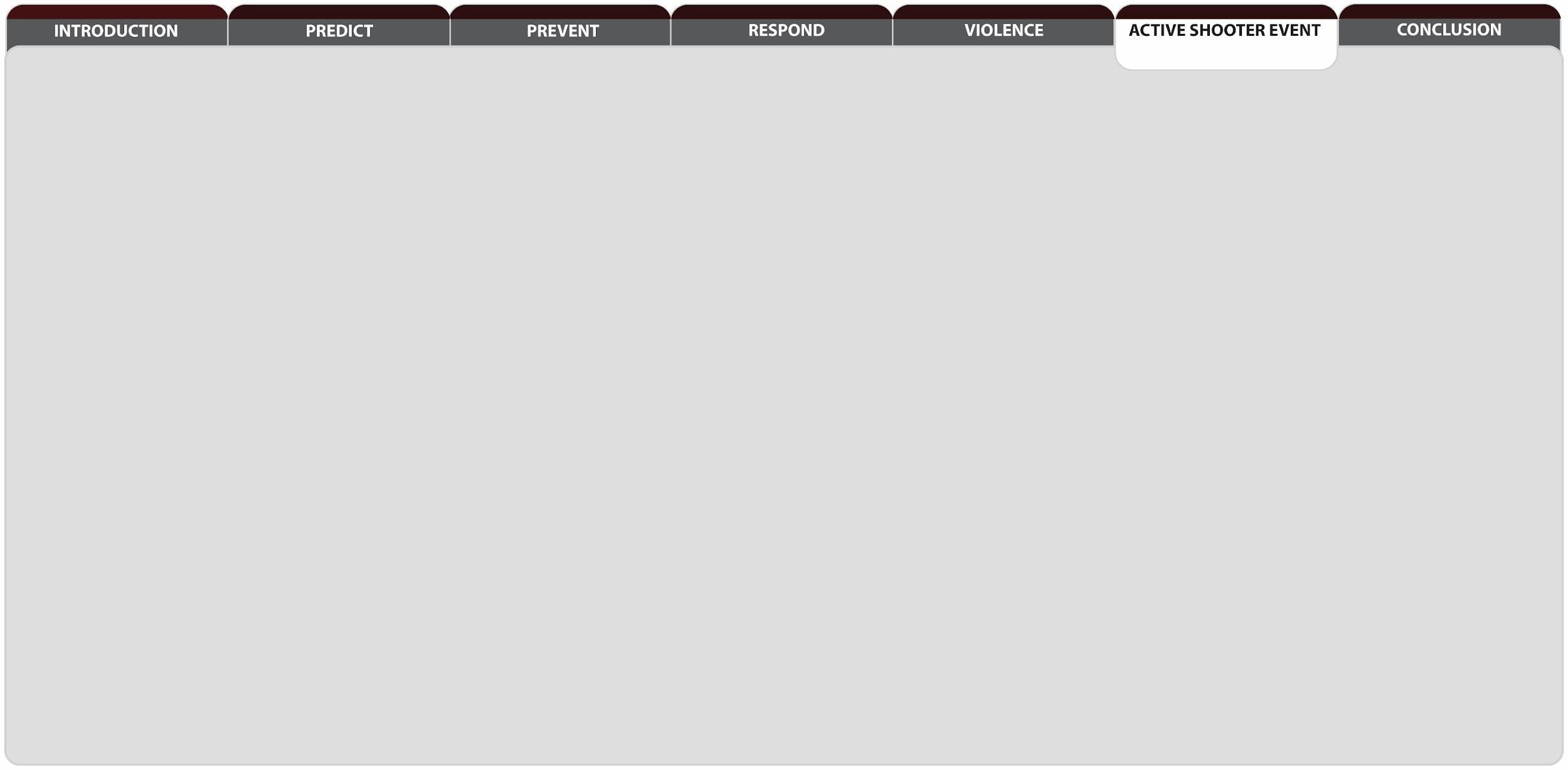


Workplace violence is now recognized as a specific category of violent crime that calls for distinct responses from employers, law enforcement, and the community. This is due, in part, to the active shooting events that are so prevalent on the news. These events are shocking and, therefore, receive a great deal of media attention.

Did you know?
You have a higher chance of being struck by lightning than being faced with an active shooter event at work. About 500 people a year are struck by lighting in the U.S.; by comparison, about 135 people are injured by active shooters every year.






Copyright Safety Provisions, Inc.
As you can see, a relationship doesn’t have to exist between an active shooter and their victims. However, the majority of active shootings do involve a professional or academic relationship between shooter and victim. That means, if you are subjected to an active shooting event, you will likely know the shooter.





Copyright Safety Provisions, Inc.

IN 42% OF INCIDENTS, SHOOTERS EXHIBITED WARNING SIGNS BEFORE THE SHOOTING


Again, violent incidents—even mass shootings—do not occur “out of the blue.” Like all acts of violence, the warning signs are present. If you are paying attention, you can predict future actions.



Copyright Safety Provisions, Inc.

Anyone can be a victim of an active shooting event, anytime, and anyplace. Typically, an active shooter event will be over within 10 to 15 minutes. For many areas, that is before law enforcement can arrive on scene. That means you must be prepared, both mentally and physically, to cope during this time of extreme stress.







Copyright Safety Provisions, Inc.
Survival Mindset
During an active shooter event, action can mean the difference between life and death. You must be determined to survive, no matter what it takes. Unfortunately, the time for the de-escalation techniques we learned about has passed by the time a shooter enters your workplace. Remember, the shooter’s intent is to injure or kill. Your intent MUST be surviving AT ALL COSTS. A survival mindset is comprised of three components: Awareness, Preparation, and Rehearsal.





Copyright Safety Provisions, Inc.

Awareness
Take time to understand your surroundings at work before an active shooter event takes place. Become familiar with the layout and location of exits. Keep yourself in Condition Yellow whenever possible. If you find yourself in an active shooter event, be aware of what is happening around you; use all your senses.


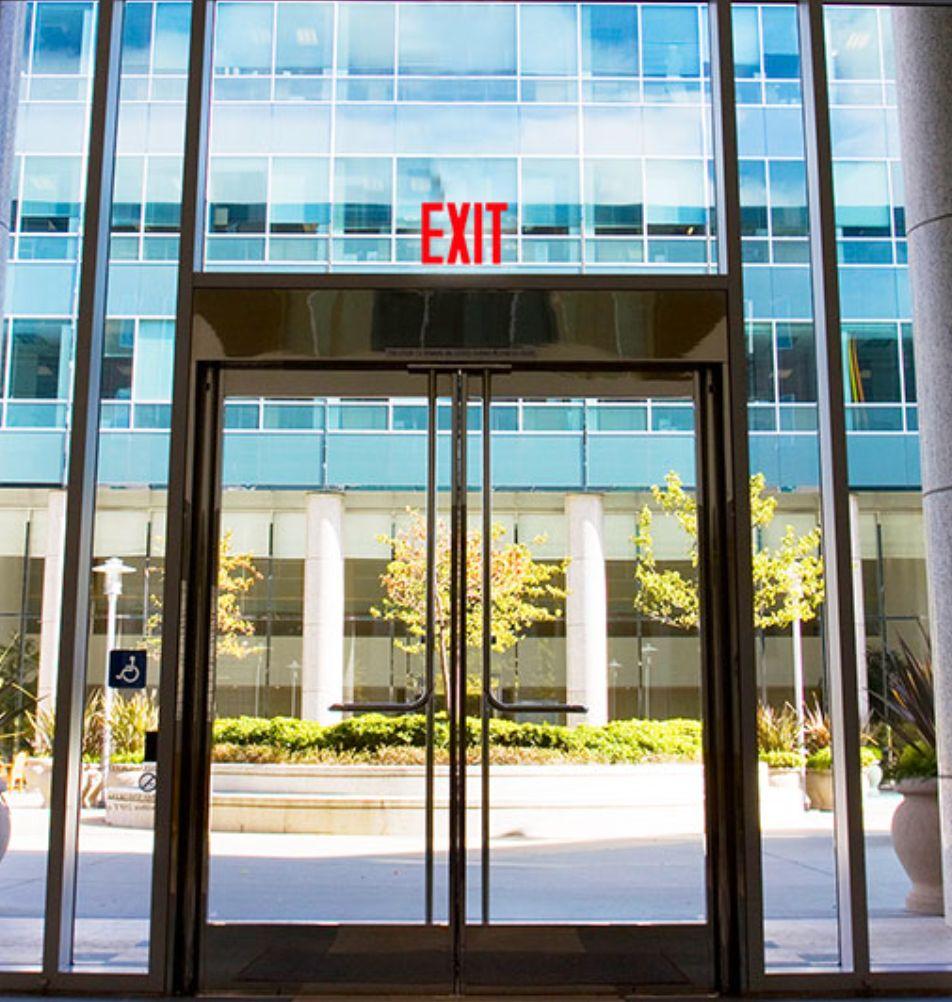


Copyright Safety Provisions, Inc.
Preparation
Ask yourself “What if” questions. Develop a plan for each of the scenarios you come up with. Be mentally prepared to do whatever it takes to survive an active shooter situation. Become a stakeholder in your own safety and security. Give yourself permission to use violence in order to protect yourself and those around you.





Copyright Safety Provisions, Inc.
Rehearsal
You can rehearse on your own by walking through your plans, but employers should hold drills yearly, as well. Participate in your company’s safety drills and take them seriously. Whatever way you find to rehearse, you should mentally and physically practice your plan so you become confident in your ability to react quickly. Remember, your life could depend on it.


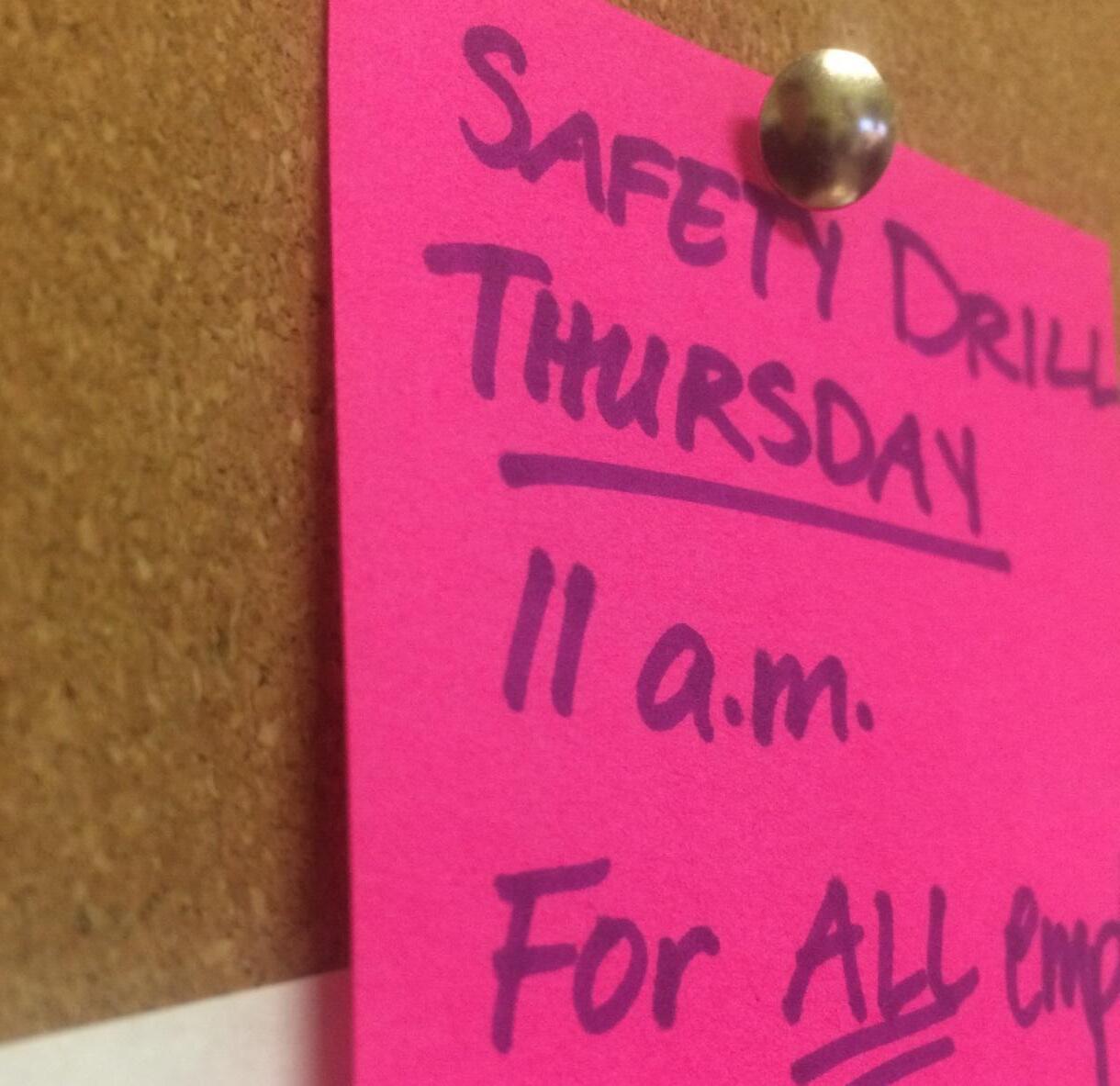


Copyright Safety Provisions, Inc.

Run, Hide, Fight
One of the best-known response plans for active shooter situations is Run, Hide, Fight. This program was created by the City of Houston and the Department of Homeland Security. It has been widely adopted as the standard protocol for active shooter events. We are not suggesting that the actions in Run, Hide, Fight be taken in that order. Sometimes, it might be safer to immediately counterattack an active shooter, rather than turn your back and run. Other times, it might be best to hide right away.




Copyright Safety Provisions, Inc.
As always, make your best determination of what is happening and which of the options below will provide the greatest degree of security for you. Running or hiding or fighting could be an appropriate initial response, depending on the circumstances. Run when it’s safe to run. Hide when it’s safe to hide. Fight if you or those around you have no other options.

OR OR




Copyright Safety Provisions, Inc.

Remember, even if you are allowed to bring a concealed weapon into your workplace, you should escape if it is safe to do so. Civilians do not get a license to enforce the law along with their concealed-carry permit. Follow your conceal-carry training, and only shoot in self-defense or in the defense of others. Running toward the sound of gunfire could, in fact, cause law enforcement officers to mistake you for the active shooter and delay their response to the actual perpetrator. Never initiate a confrontation with an active shooter.




Copyright Safety Provisions, Inc.
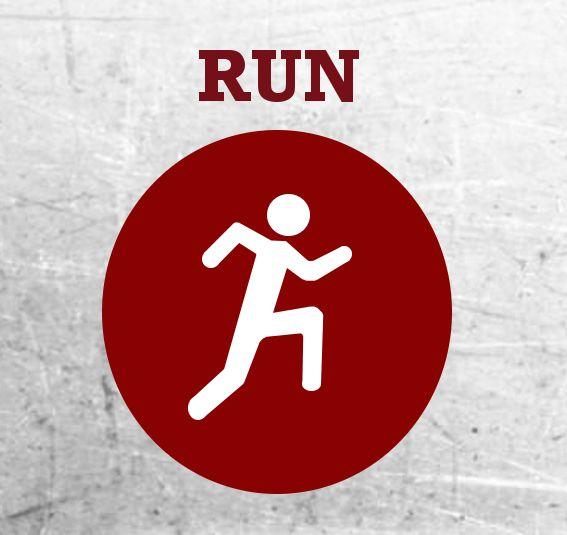
If you have access to an escape path, attempt to evacuate yourself and others. You can use the route mapped out in your Emergency Action Plan, if it is safe. If not, think of another way out that keeps you away from the area where the shooter may be. Leave your belongings behind. Your purse, jacket, or cell phone is not as important as your life.




Copyright Safety Provisions, Inc.

While you are escaping, you may run into others who are fleeing, as well. If you know where the shooter may be, direct anyone you meet away from them. Try to help others escape, but if they do not agree to follow you, respect their wishes and leave them behind. Don’t waste time arguing. Some people may feel more comfortable hiding, which we’ll discuss in a moment.

Reminder!
Spraining an ankle, falling down stairs, or aggravating an existing medical condition are all ways to injure yourself during an active shooter event. Exit as quickly and as safely as possible.




Copyright Safety Provisions, Inc.

Helping The Wounded
Unfortunately, you may also come across injured or wounded individuals while you are evacuating. Only move a wounded person if they are in immediate danger. In this case, you can help them to safety. Hide with them, if it is safe to do so, and administer first aid as needed.





Copyright Safety Provisions, Inc.
Call 911
Call 911 when you are safe. Give the dispatcher any information you have in a clear, calm manner. If possible, alert them to the shooter’s location, and any injured or wounded individuals. If it is unsafe for you to speak, leave the line open and allow the dispatcher on the other end to listen. Once you are out of the building, go to your company’s meeting spot, if you have one.


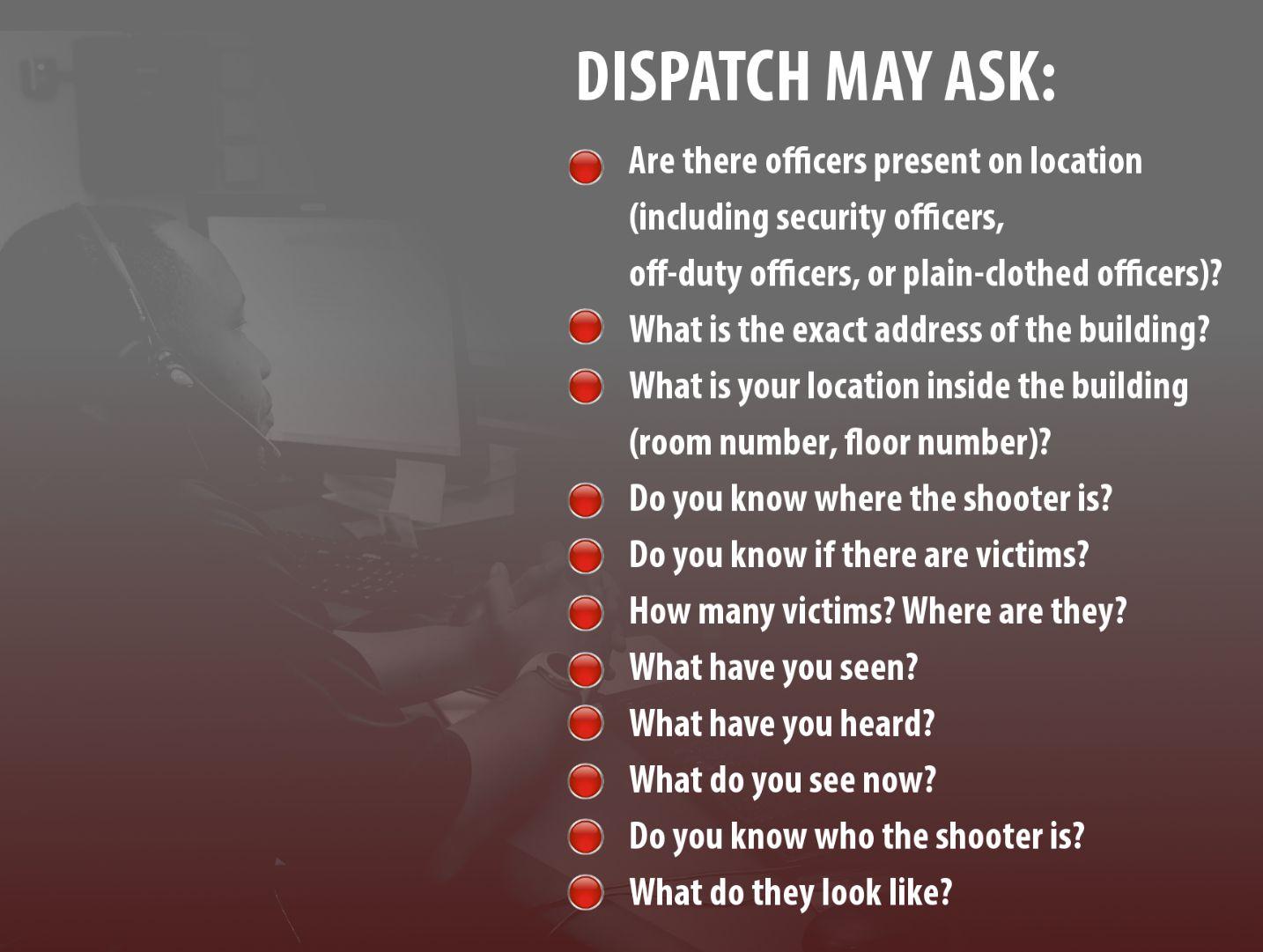


Copyright Safety Provisions, Inc.

Sometimes, evacuating isn’t possible. Perhaps the shooter has blocked the exit nearest you, or maybe you’re a guest or visitor and you’re not familiar with the building. Whatever the reason, if you cannot evacuate safely, then you should hide if it is safest.




Copyright Safety Provisions, Inc.
Your hiding place should be where the active shooter is less likely to find you. It should be inconspicuous or out of the normal flow of foot traffic. Try to find a hiding place that would protect you if shots are fired in your direction. An office or any other room with a door (restroom, conference room, etc.) would work best as a hiding place. If you are able to find a room with a lock on the door, lock it.

Did you know?
Cover will protect you from gunfire. Concealment will merely hide you from view. Choose the best hiding space that is available to you, and do so quickly.





Copyright Safety Provisions, Inc.

Blockade the door with heavy furniture. Use as many items as you can. Once the door is blocked, turn off the lights and hide behind large items, like cabinets or a desk. Silence your phone and any other sources of noise that might catch the active shooter’s attention, including radios, computers, or televisions.





Copyright Safety Provisions, Inc.
If you can’t find an office, or can’t get to one safely, find a hiding spot that is as close to the floor as possible. Hiding under a desk is a good option. Silence your phone and stay as quiet and as still as you can. Again, call 911, if possible. Stay hidden until law enforcement officers give you the all clear.
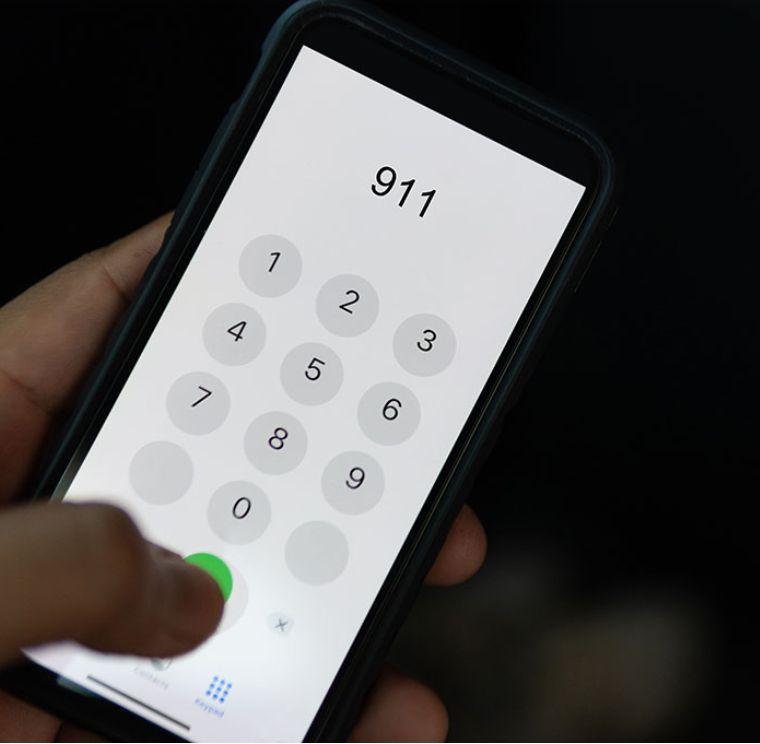





Copyright Safety Provisions, Inc.

Again, you should never seek out an active shooter and instigate a confrontation. Only resort to the fight response if you or others are in imminent danger. That is to say, only fight in order to save your own life or the lives of others.




Copyright Safety Provisions, Inc.
The first step to take if you are in this situation is to try to remain calm. Many people who thought they could never defend themselves or others have done so when needed. You can, too. Remember your survival mindset: you MUST survive. Fully commit to defending yourself and others with physical action. If there are other people with you who do not wish to fight back, do not force them to do so.


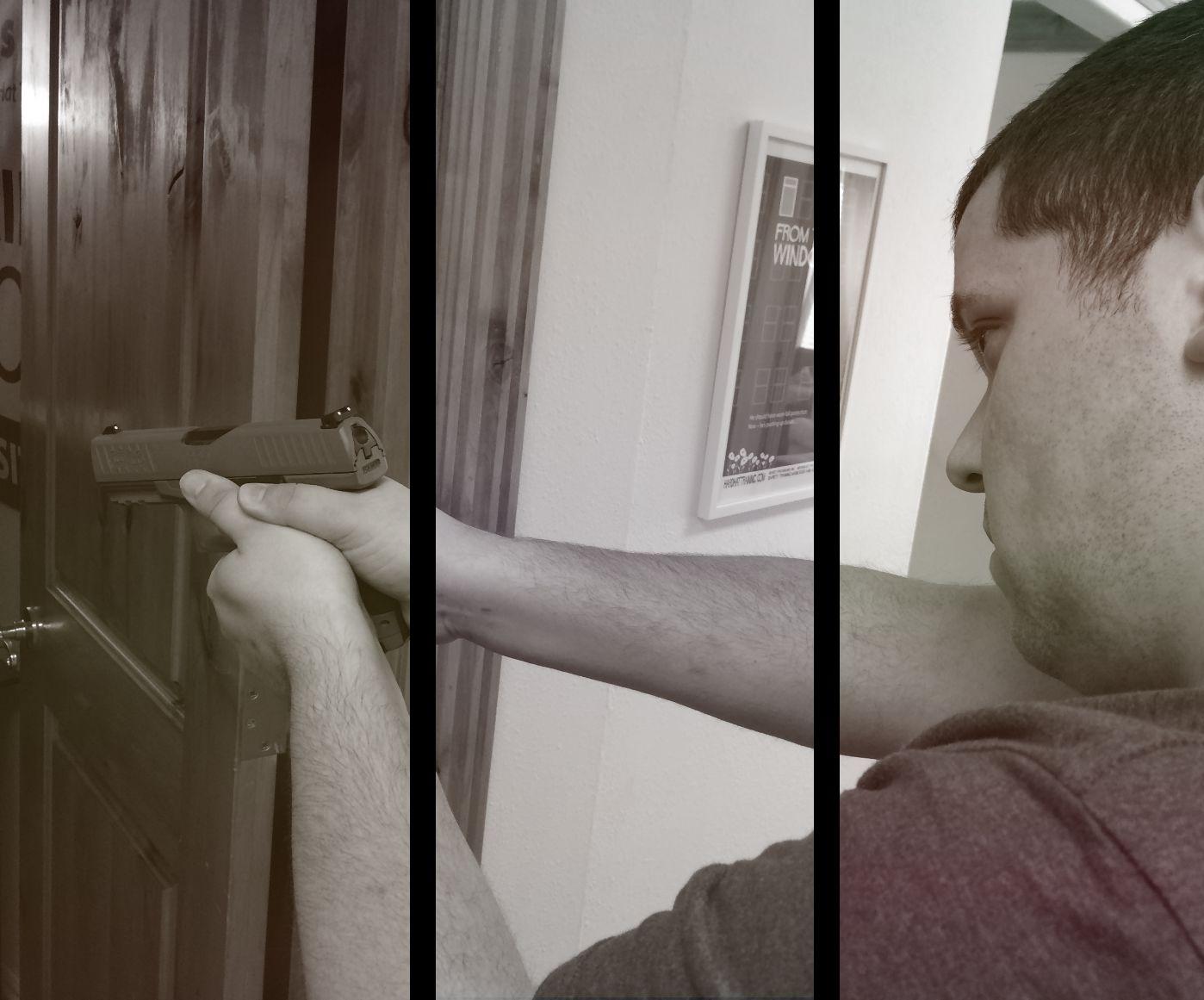


Copyright Safety Provisions, Inc.

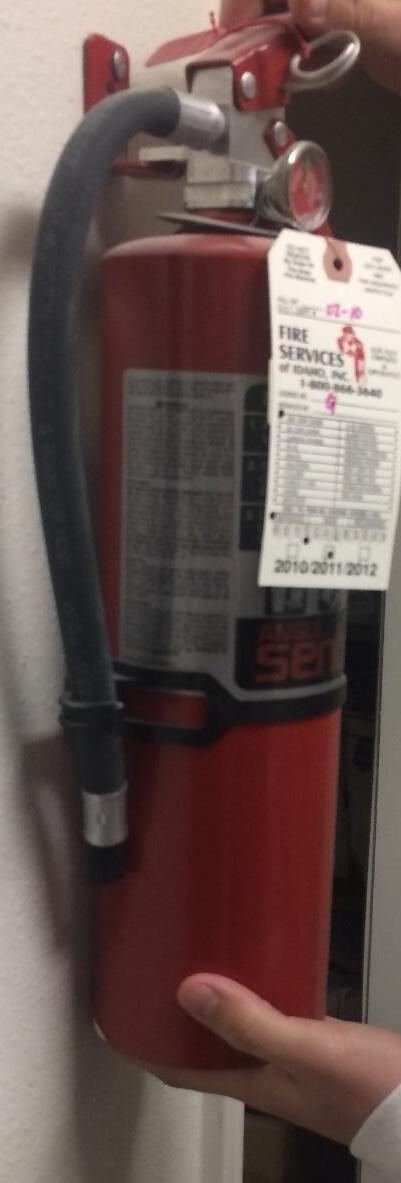





If you have time, look around for objects you can use as weapons and be committed to using them, if necessary. Almost every office, church, or classroom has items that can be used for protection. We’ve provided a list below. Take a few minutes to look it over.


Copyright Safety Provisions, Inc.
Finally, act as aggressively as possible when confronting the active shooter. Scream, yell, and throw the objects you found. If you have larger items, you can use them to hit the shooter. The goal here is not to kill the shooter. Rather, you should try to distract and disarm them.
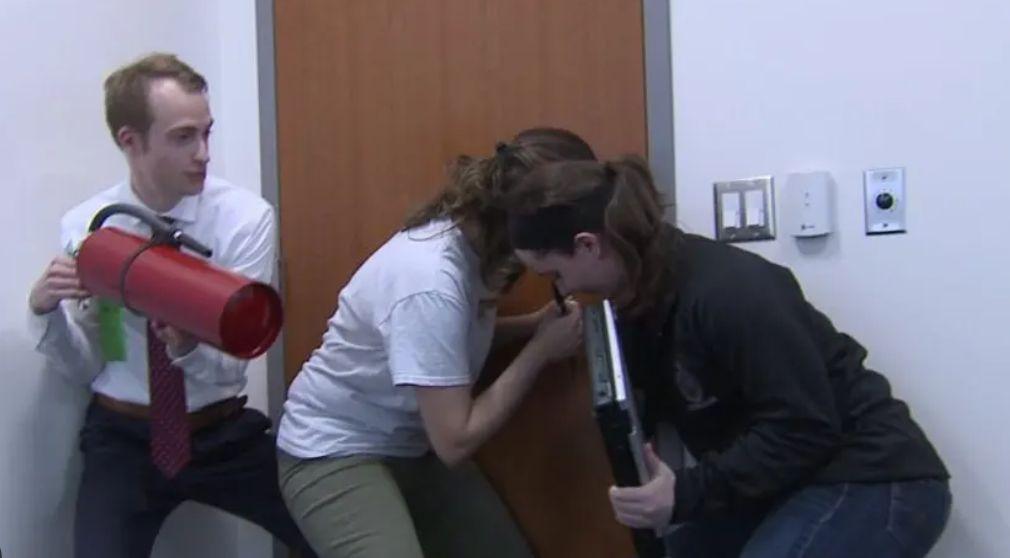
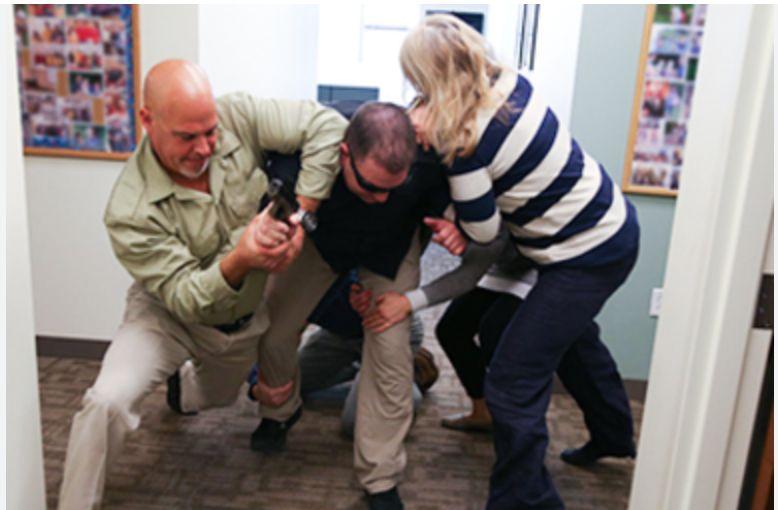




Copyright Safety Provisions, Inc.

When Law Enforcement Arrives
Law enforcement’s purpose is to stop an active shooter as quickly as possible. When they arrive, they will go immediately to the area where shots were heard last. Officers will not stop to assist the wounded until the shooter is no longer active. It is their job to secure the scene and make sure no one else gets hurt.
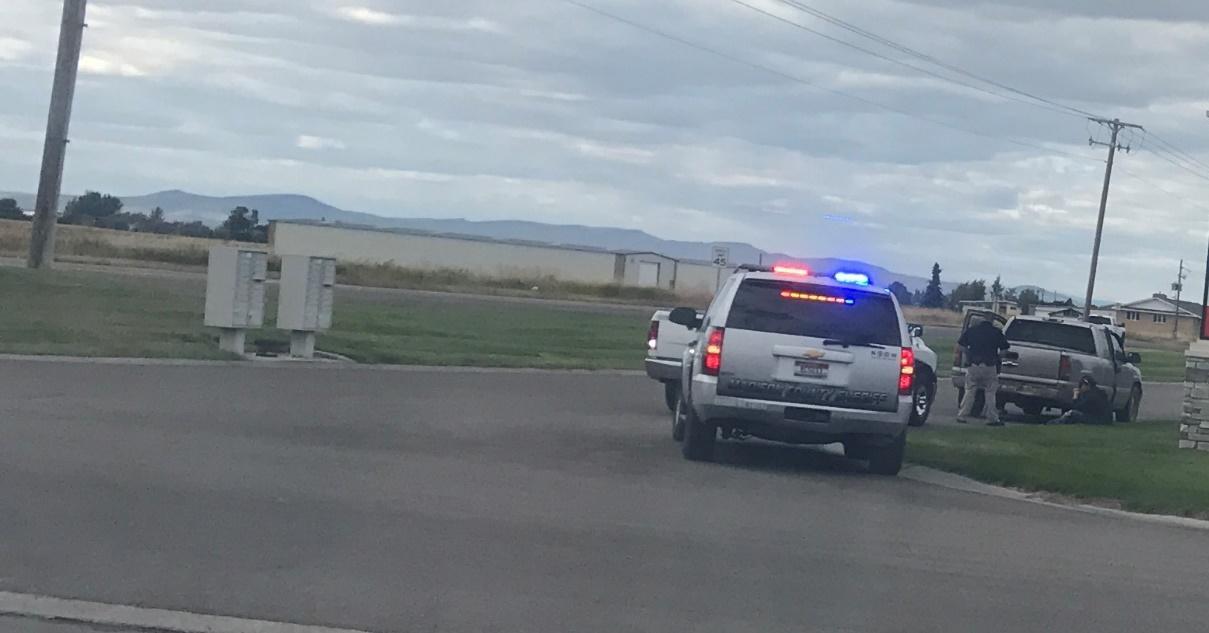

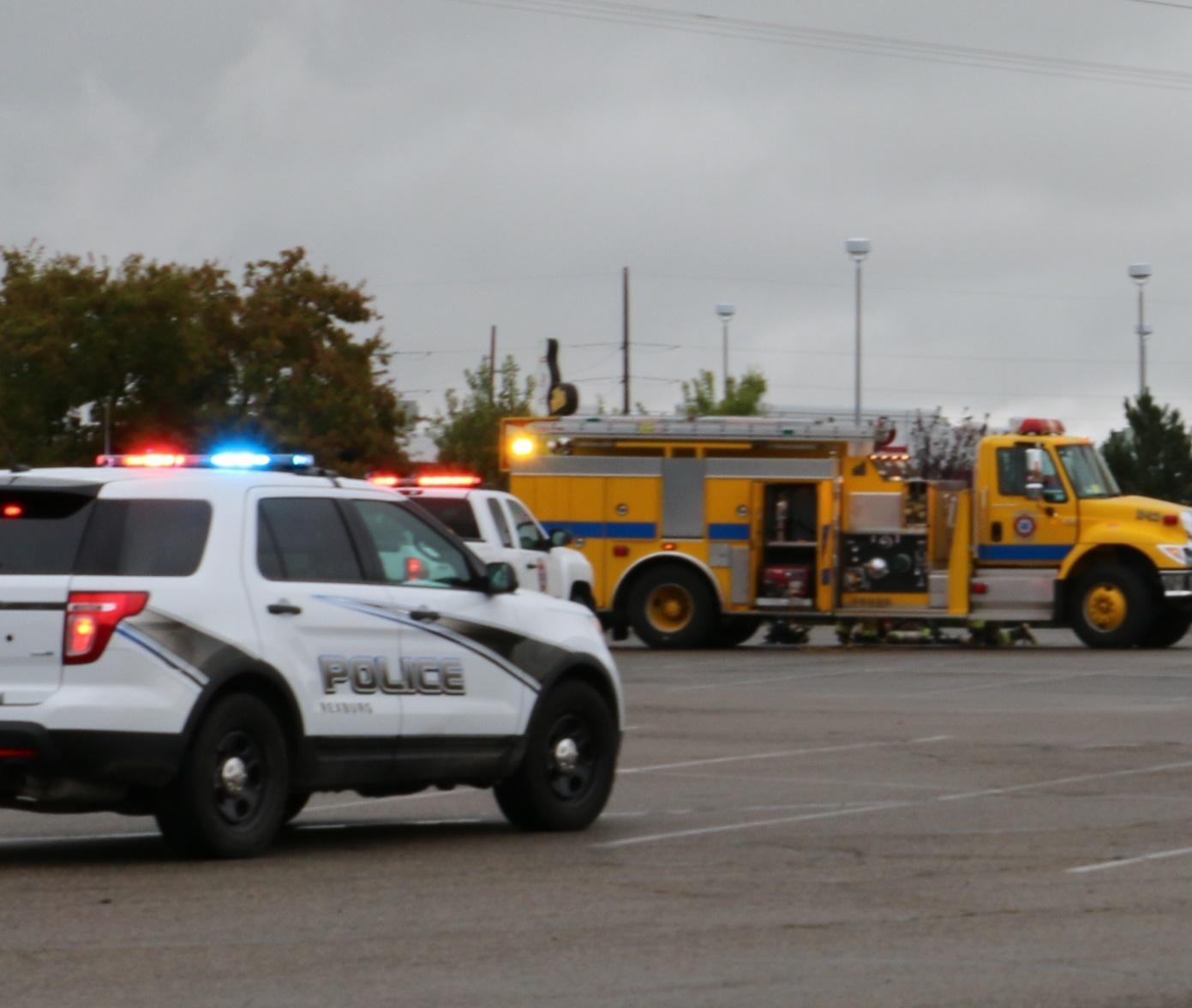


Copyright Safety Provisions, Inc.


Emergency personnel may be responding from several different departments or assignments. They may be wearing uniforms you don’t recognize, or even street clothes. They may have handguns, assault rifles, or police K-9s. Do not be shocked by their appearance or any variations of uniforms. All law enforcement officials are trained to react quickly and work together during emergencies.




Copyright Safety Provisions, Inc.
When you are approached by the first officers on the scene, keep your hands visible at all times. This lets the officers know you are not a threat and allows them to move quickly past you to find the shooter. Do not point, scream, or otherwise distract or alarm them. Remain calm and allow them to do their job.

Do not run toward law enforcement officers when you see them. They are not there to escort you from the building—they are there to stop the active shooter. Remain where you are until officers move past you, then exit the way they came in.
If you are given instructions by any law enforcement officer, follow them promptly and exactly. Take some time to review the Dos and Don’ts of how to react when law enforcement arrives on the next slide.




Copyright Safety Provisions, Inc.






Copyright Safety Provisions, Inc.




Emergency medical teams will arrive after the officers. They will treat and remove anyone who is wounded or hurt in any way. Medical teams may ask those who are not hurt to help evacuate the wounded. If you are asked to assist, do so. Those who are injured should be treated promptly and thoroughly.


Copyright Safety Provisions, Inc.



Once you are safely outside, go to your company’s meeting point, if they have one. Law enforcement officers will likely keep everyone in that area until the situation is under control, and all witnesses have been identified and questioned. It is essential that you do not leave this location until authorities have instructed you to do so.



Copyright Safety Provisions, Inc.

Incident Investigation
An investigation into the violent incident—whether it was an active shooter or other type of violent event—will often be conducted at the same time as any post-trauma intervention. Investigations can be especially upsetting for employees who were personally involved in, knew co-workers involved in, or witnessed the event. It is important the investigation be conducted in a professional and sensitive manner so it doesn’t further traumatize employees. Investigators will be either trained internal staff or outside law enforcement, and possibly both.





Copyright Safety Provisions, Inc.

Incident investigations are invaluable, as they gather information that helps improve workplace violence prevention and response. If you are a part of an investigation, you should speak frankly and honestly to investigators and law enforcement. Give as many details as you can. Don’t be intimidated by the investigators or the process.




Copyright Safety Provisions, Inc.
Incident Debriefing
A critical incident debriefing is a setting where everyone affected by the incident can discuss their feelings and concerns. It also gives an open forum for suggestions to keep further violence from erupting. This can take place in a group setting or one-on-one.





Copyright Safety Provisions, Inc.
Psychological Support
Early intervention can slow or even prevent trauma from spreading throughout the employees. For this reason, emergency psychological services should be offered to victims, coworkers, and family members as soon as possible.






Copyright Safety Provisions, Inc.
As we mentioned at the beginning of this training, the effects of workplace violence do not go away after the incident. Everyone in the workplace is impacted by the violence, not just the victim, and they will need healing afterward. Long-term support should be provided for the comprehensive treatment of victims, witnesses, or any other employee who was traumatized. Counseling should be conducted by a well-trained professional who understands the issues associated with assault and its consequences.





Copyright Safety Provisions, Inc.
Conclusion
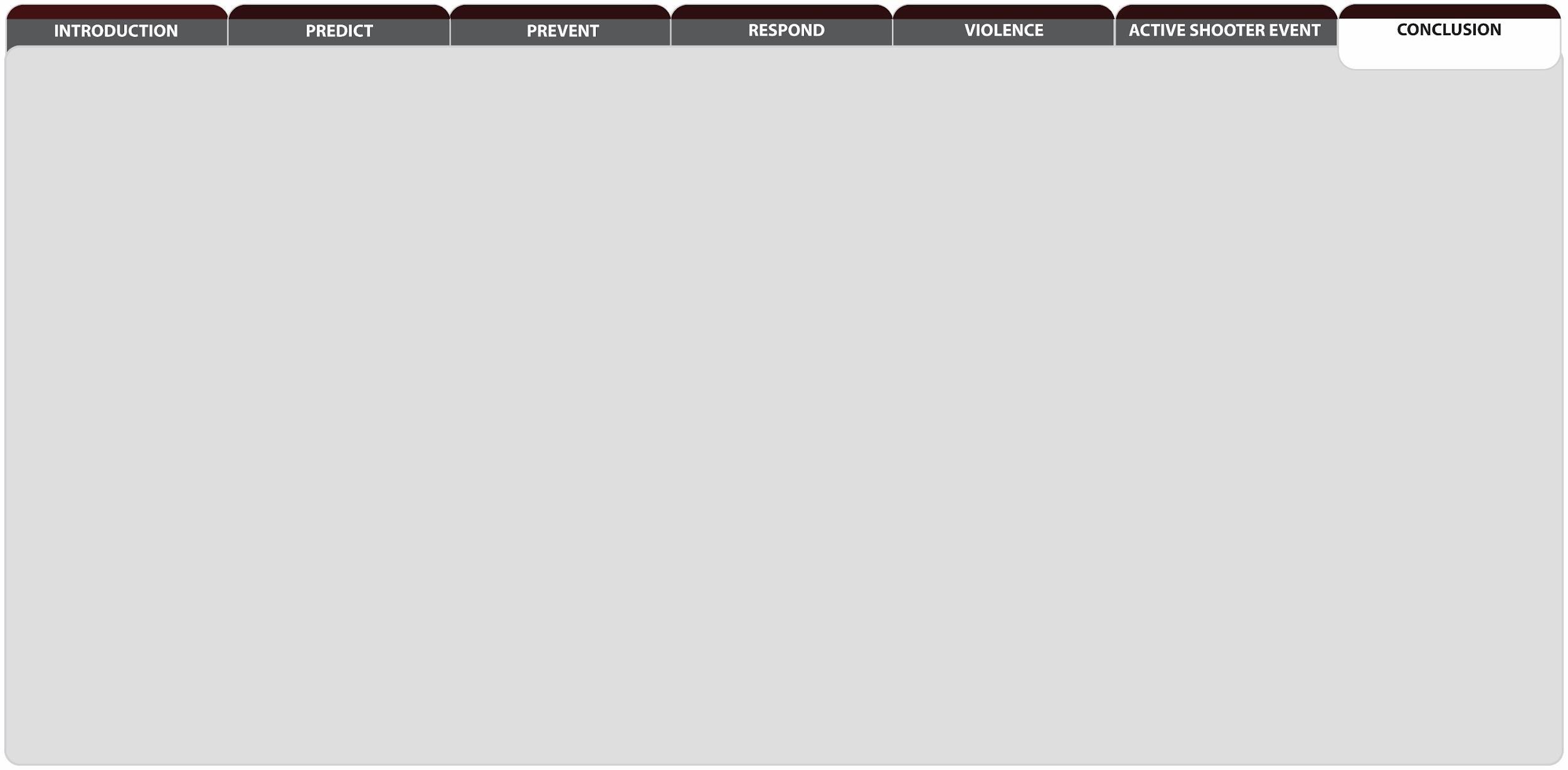



No matter how effective your work policies and plans are, there are no guarantees about violence in the workplace. Even the most dedicated employers face this issue. However, when violence does occur, the response must be timely, decisive, and appropriate.





Copyright Safety Provisions, Inc.

Workplace violence will not stop on its own – it’s up to all of us to fight against it. We cannot be complacent bystanders and expect our workplace cultures to change themselves. You now have the tools and information you need in order to maintain a safe and productive workplace for yourself and those with whom you work.







Copyright Safety Provisions, Inc. SOFG Inc. | peopledevelopment@altardstate.com








































































































































































































































































































